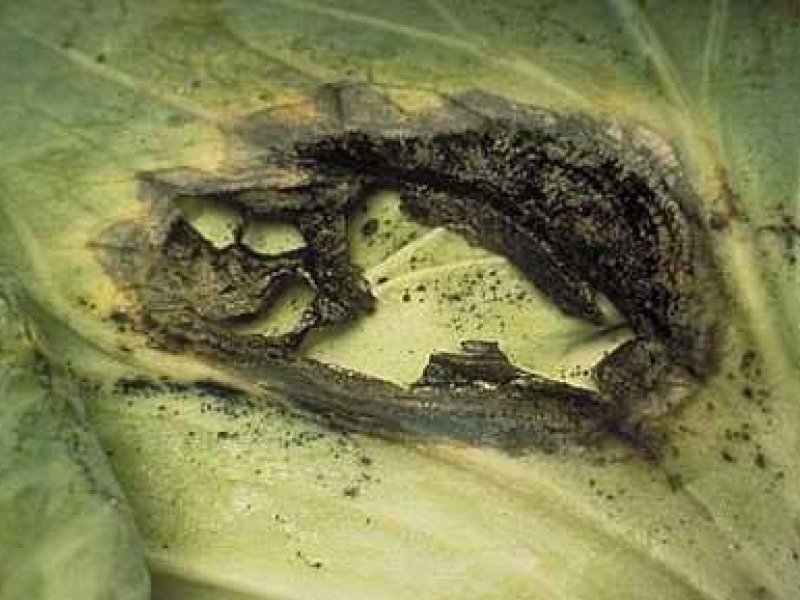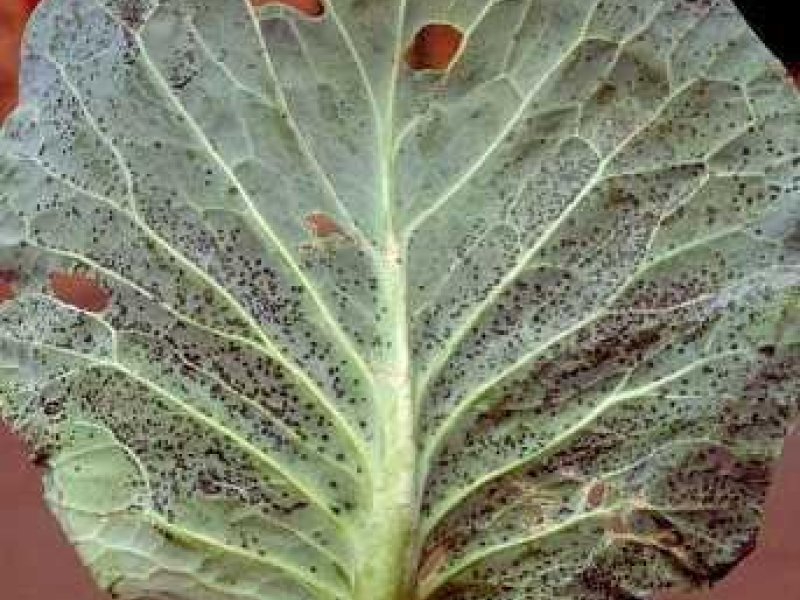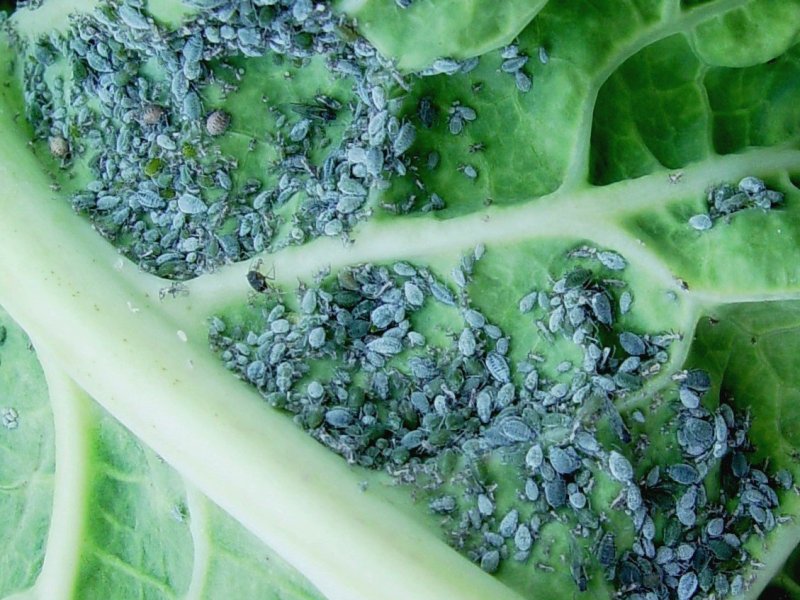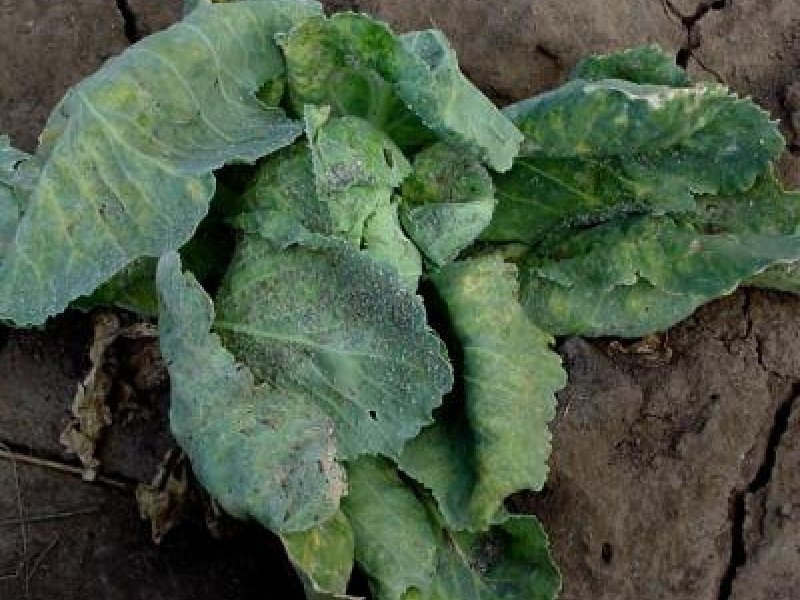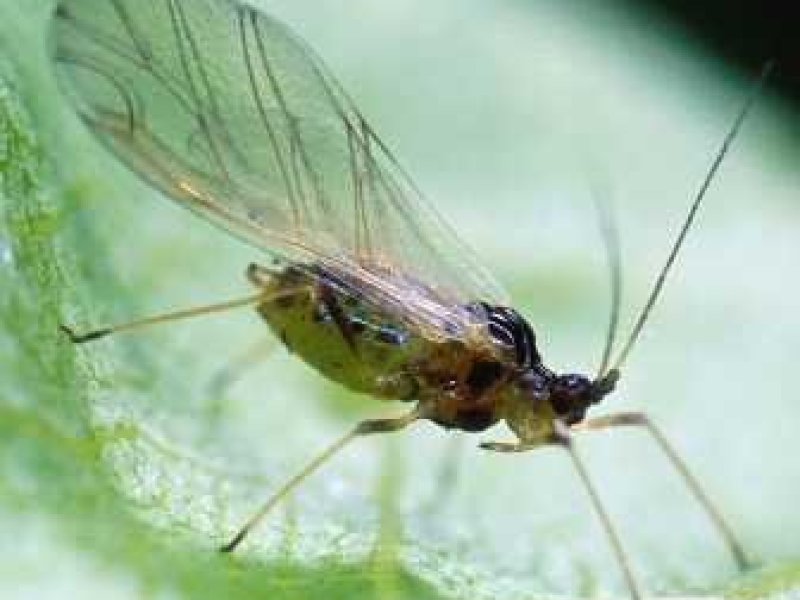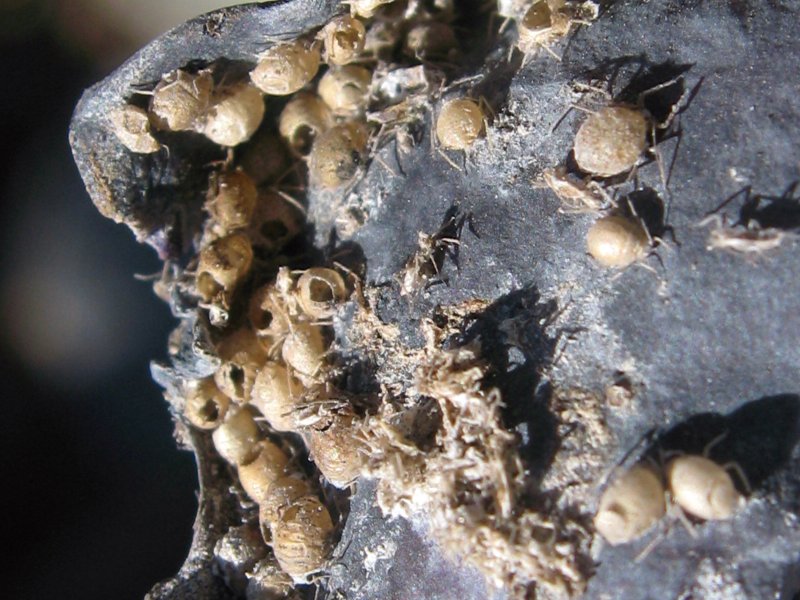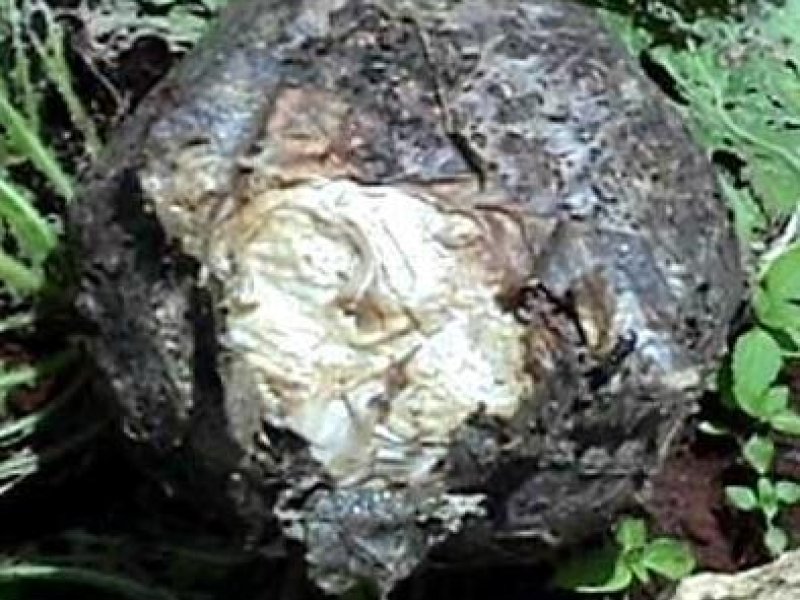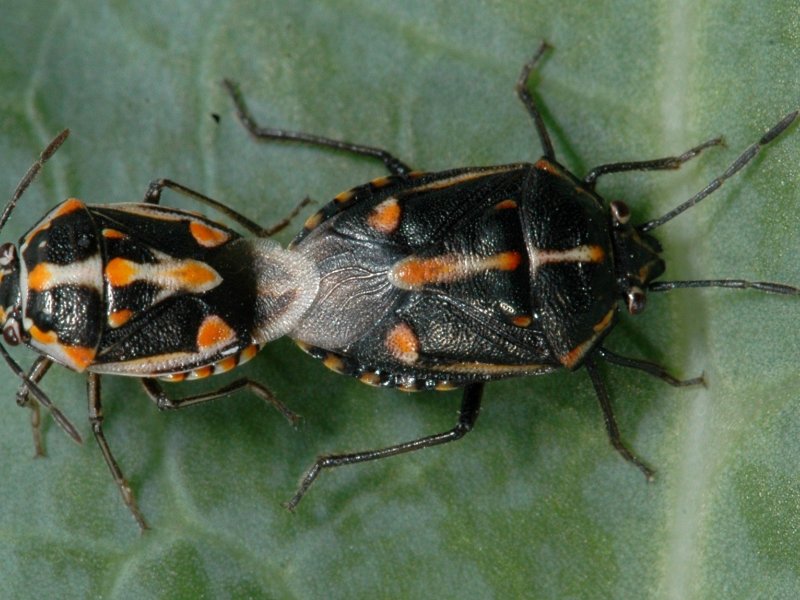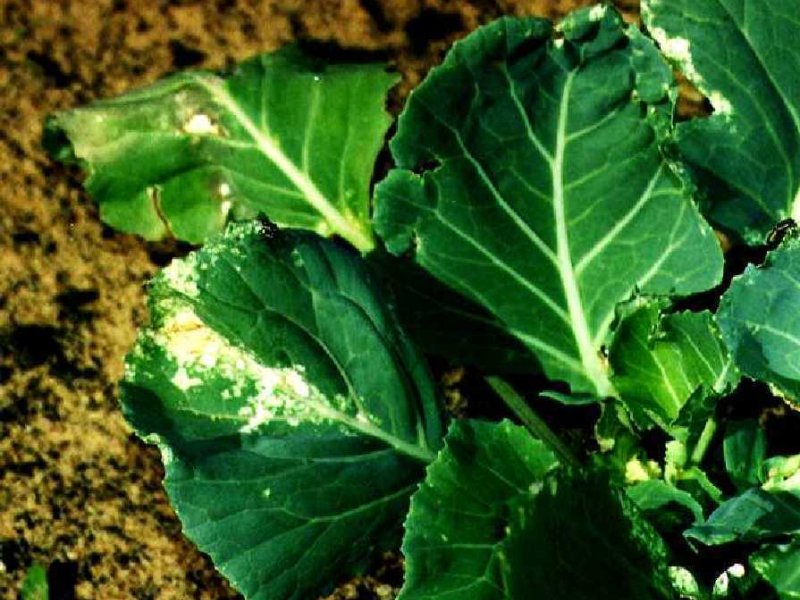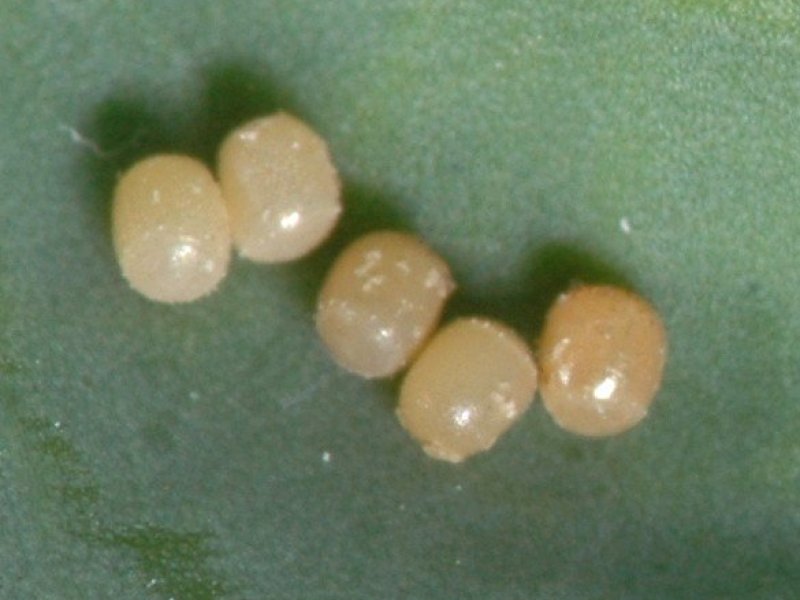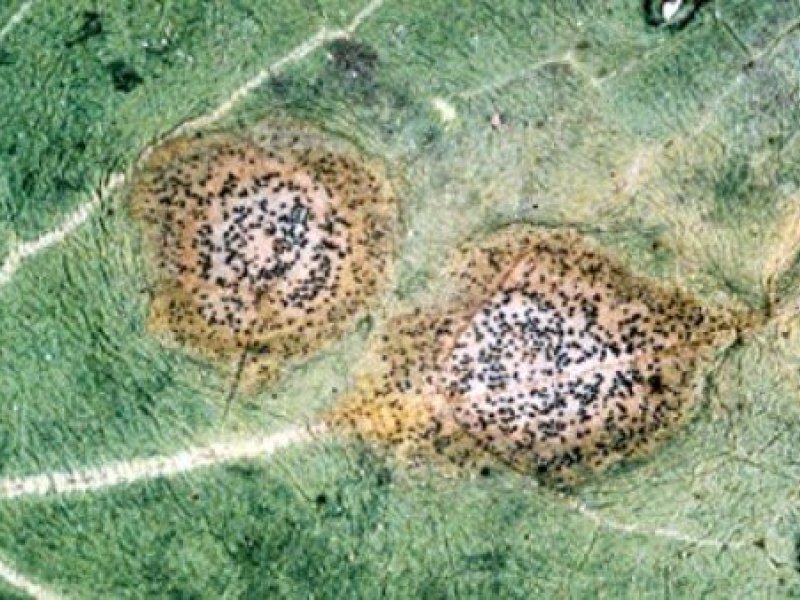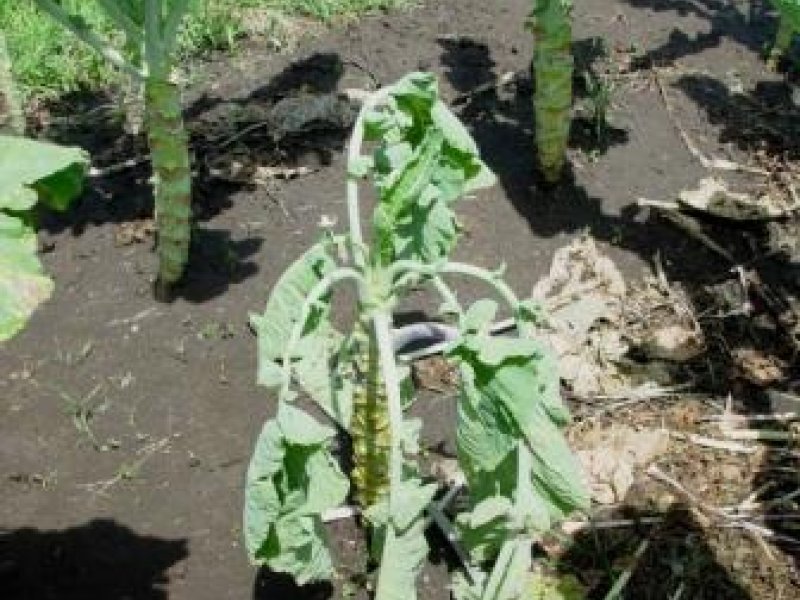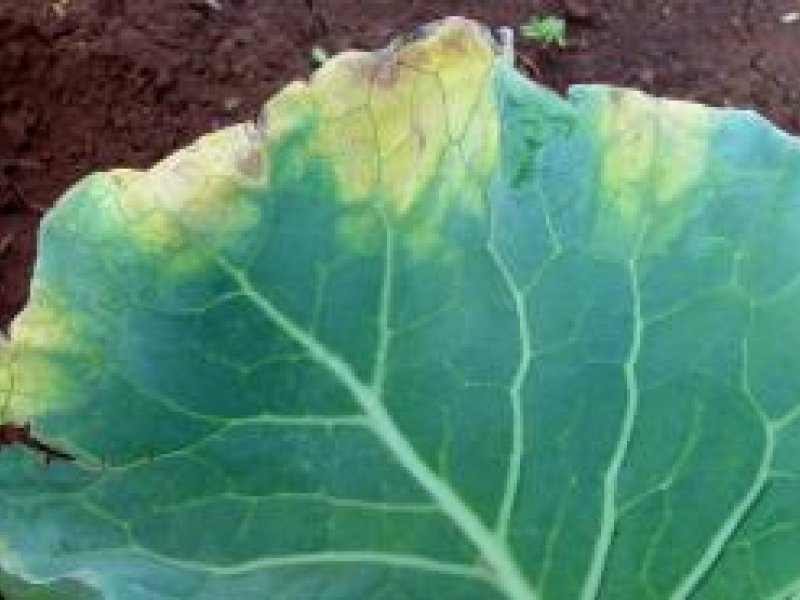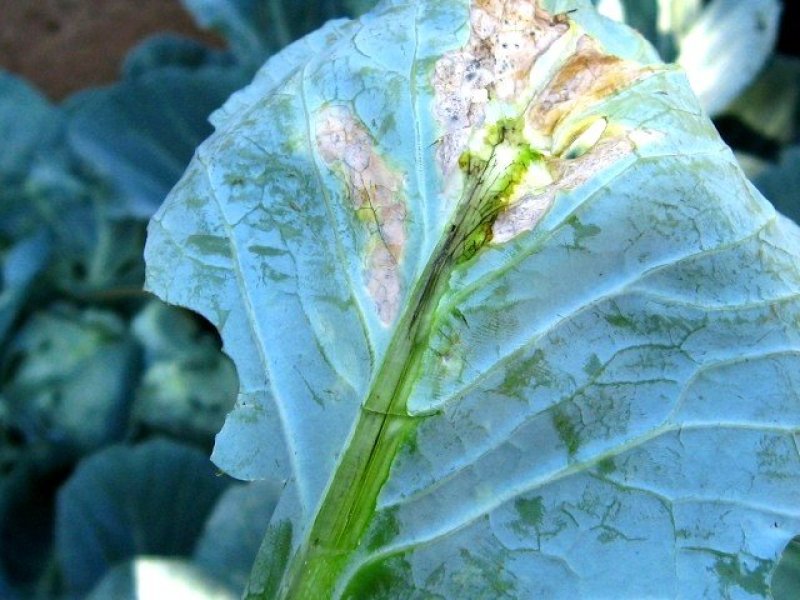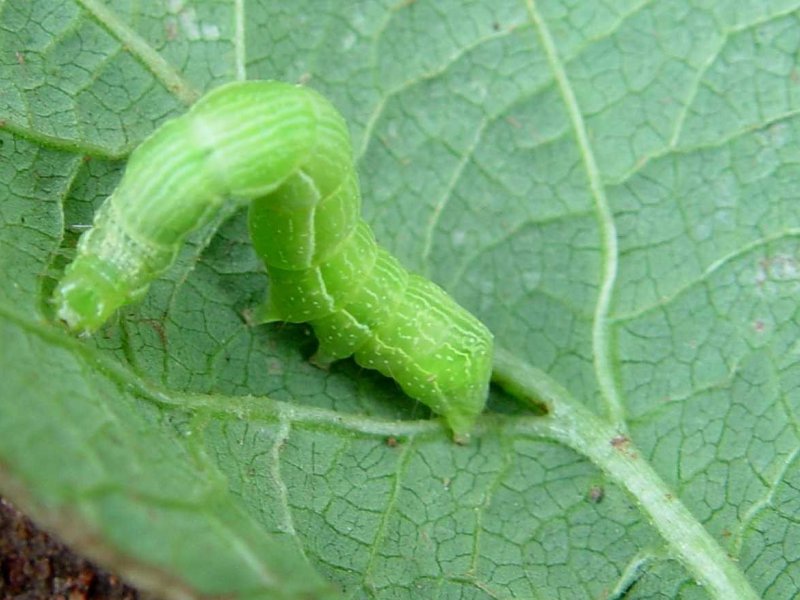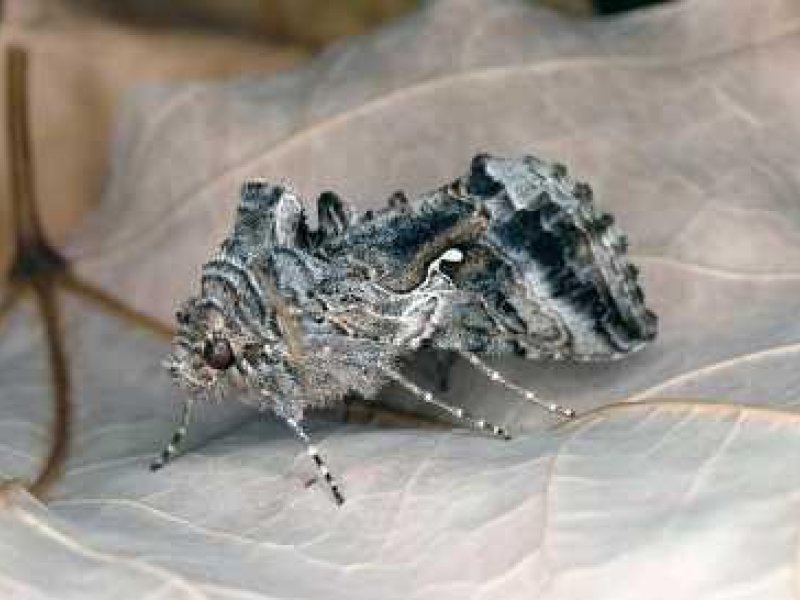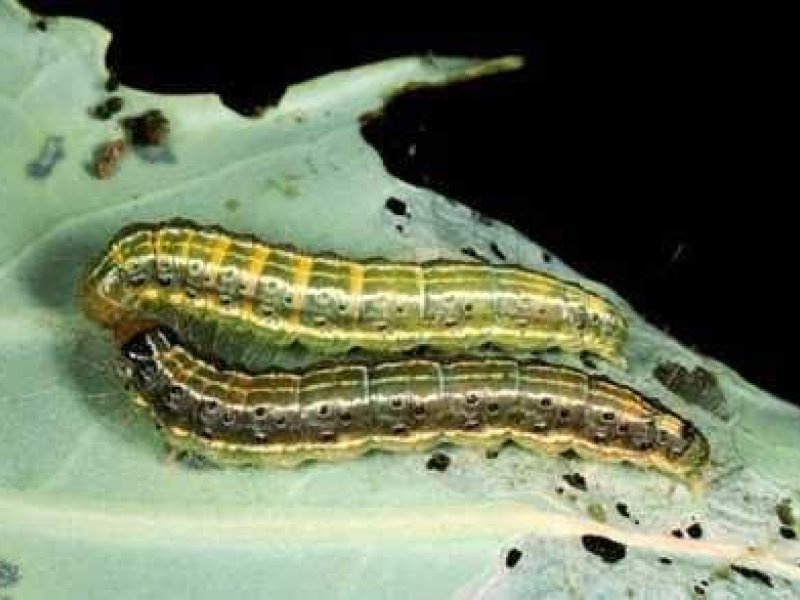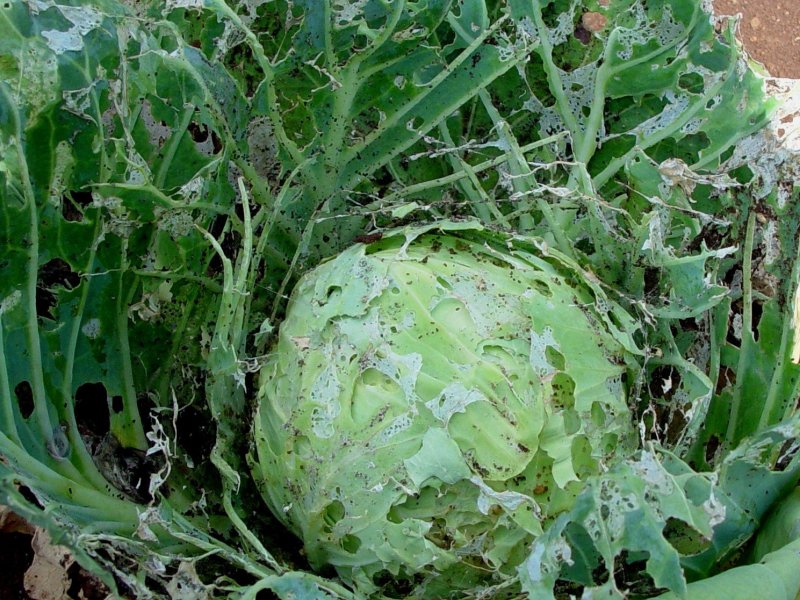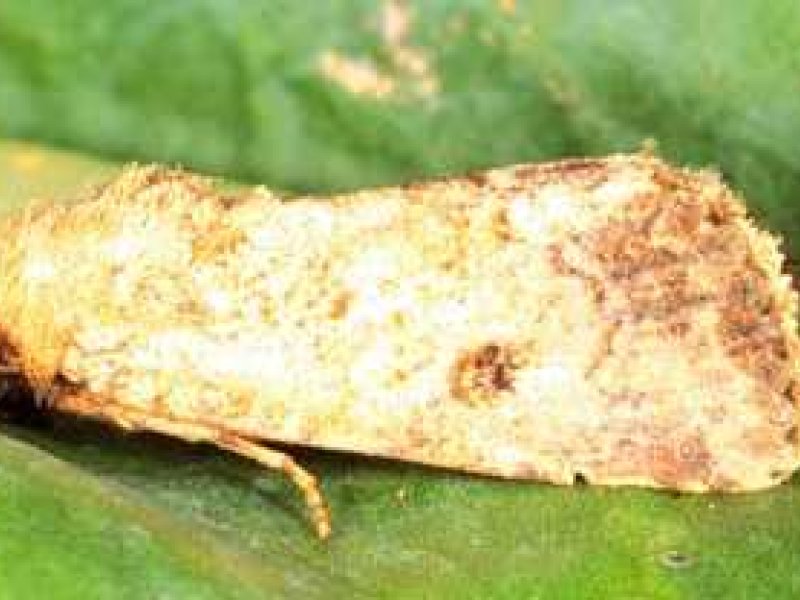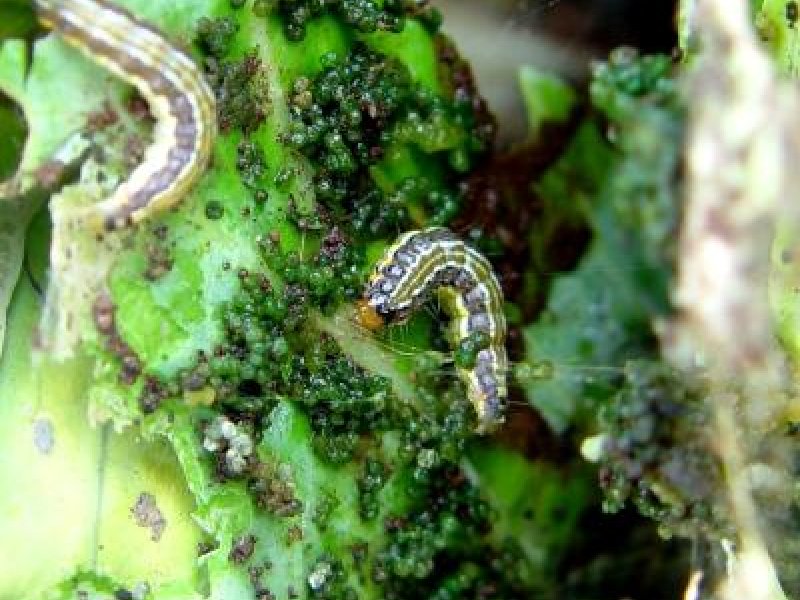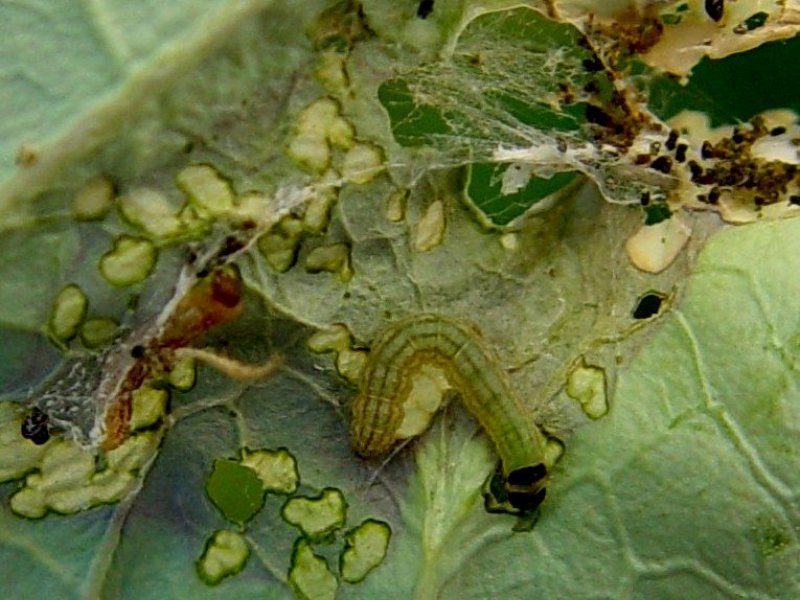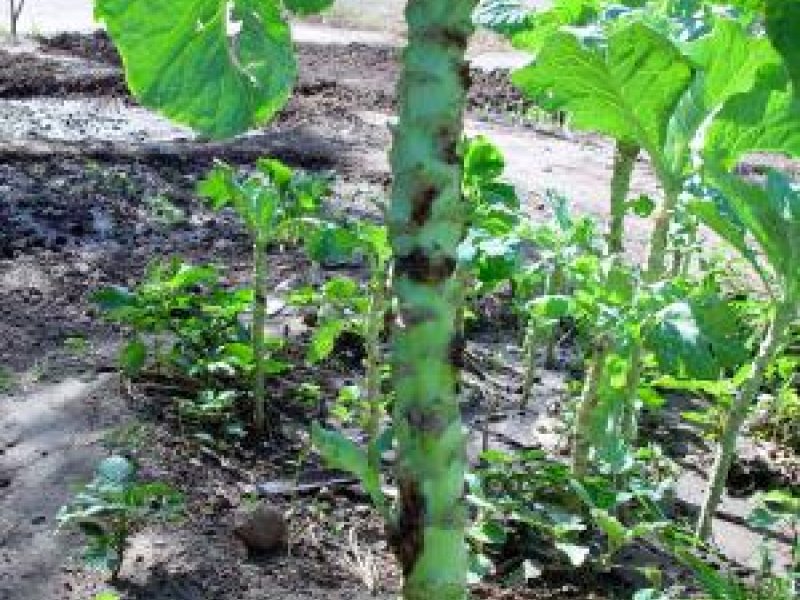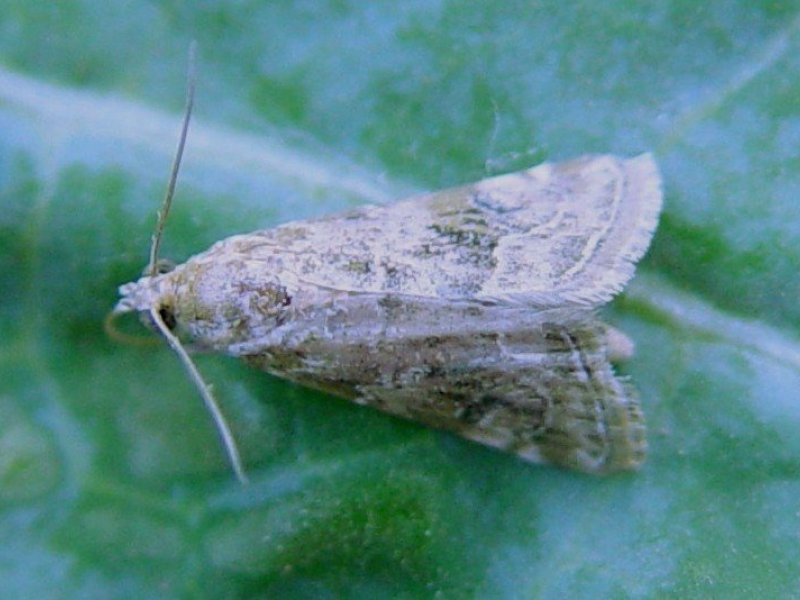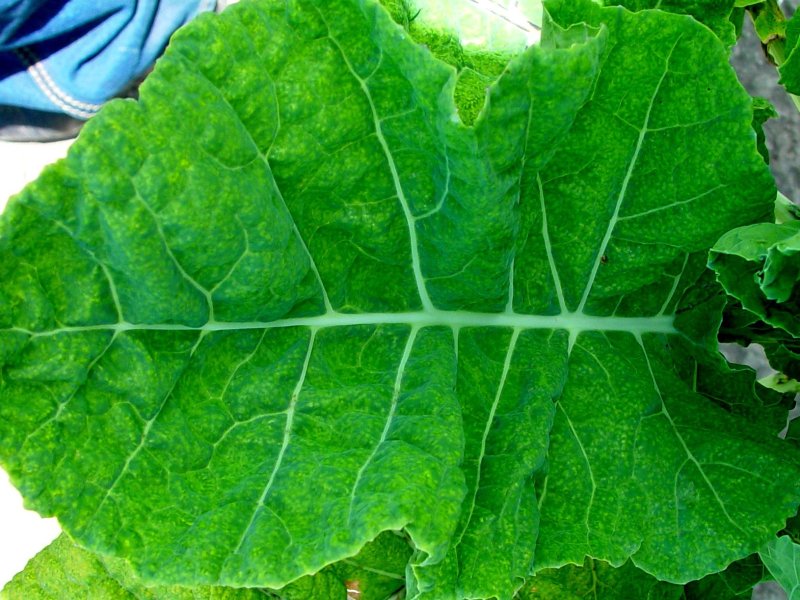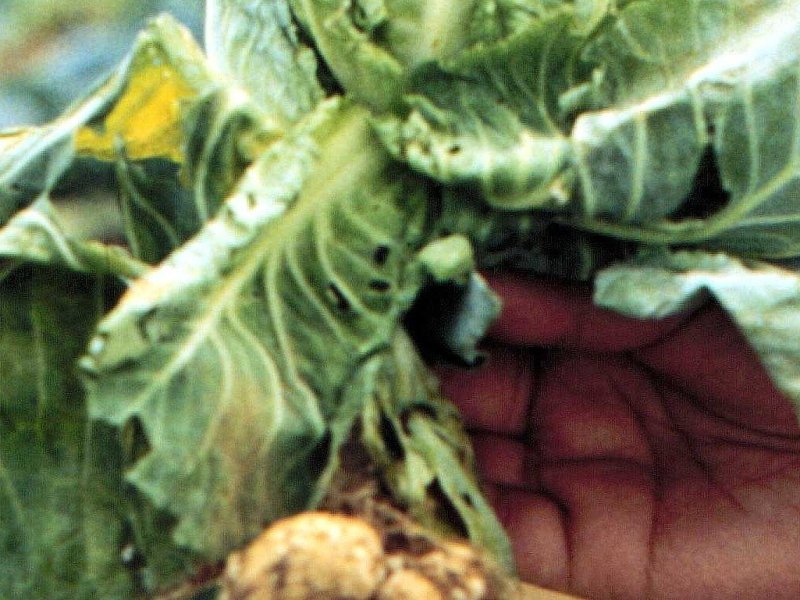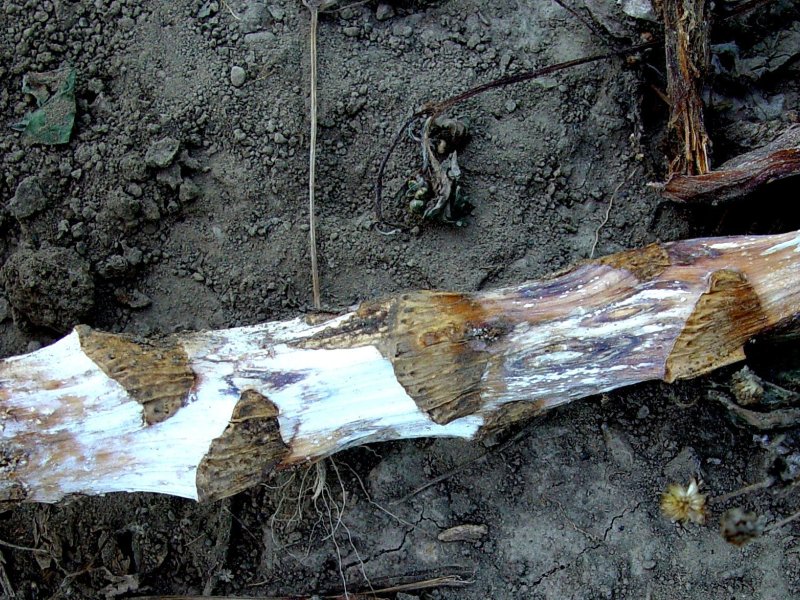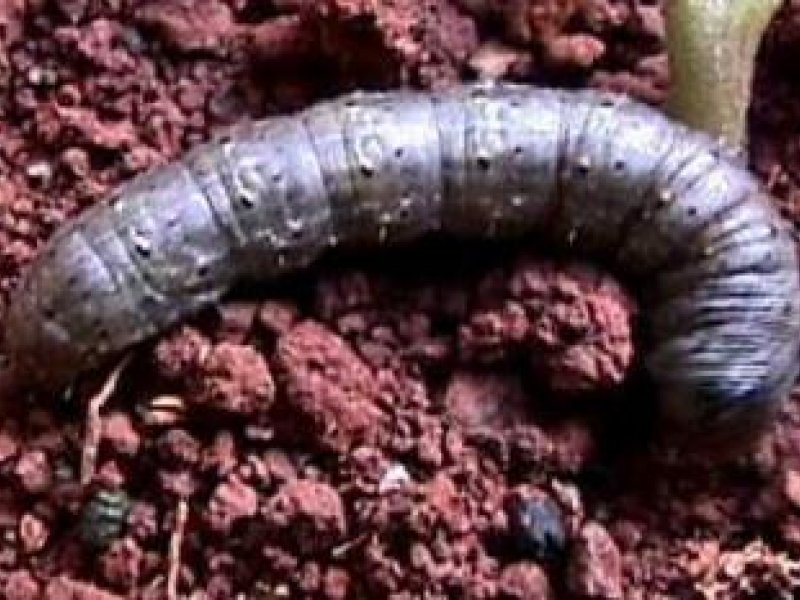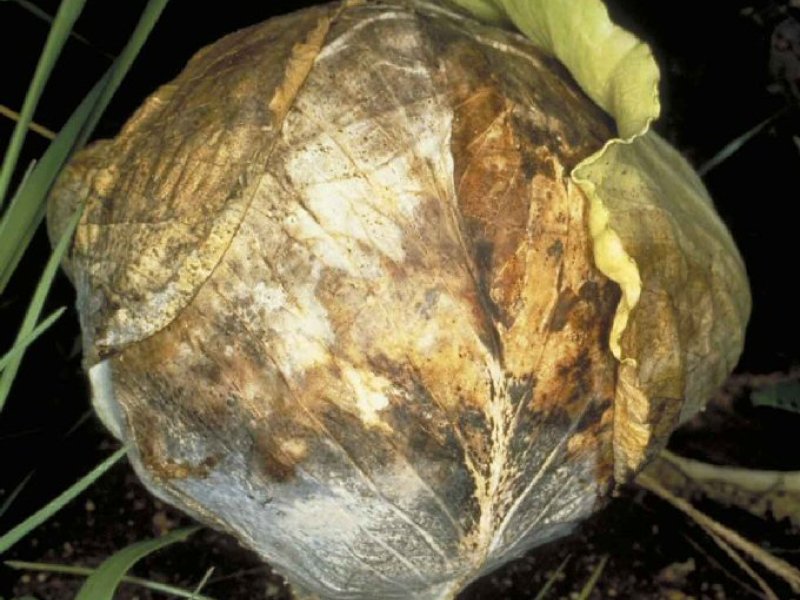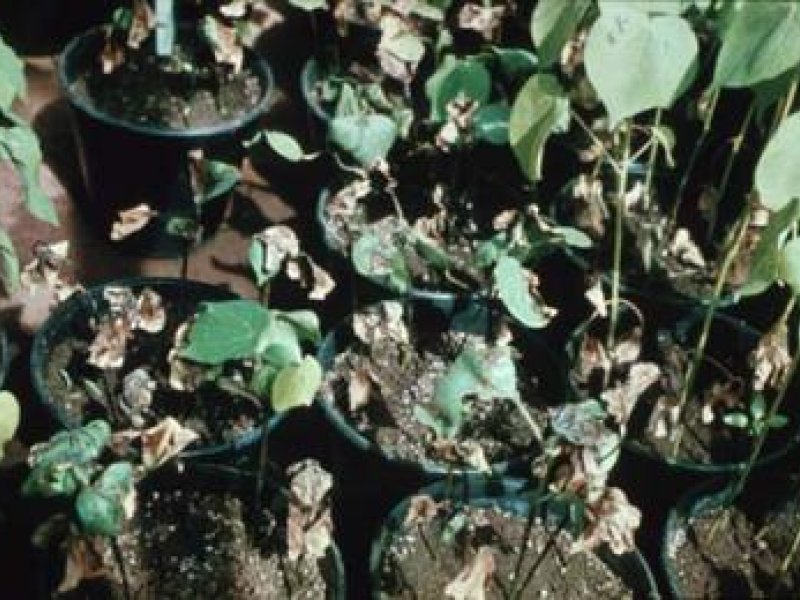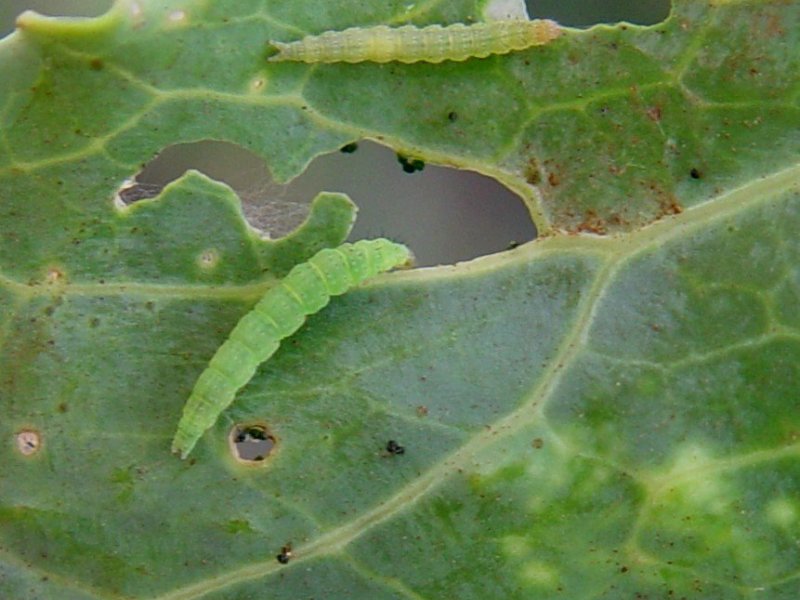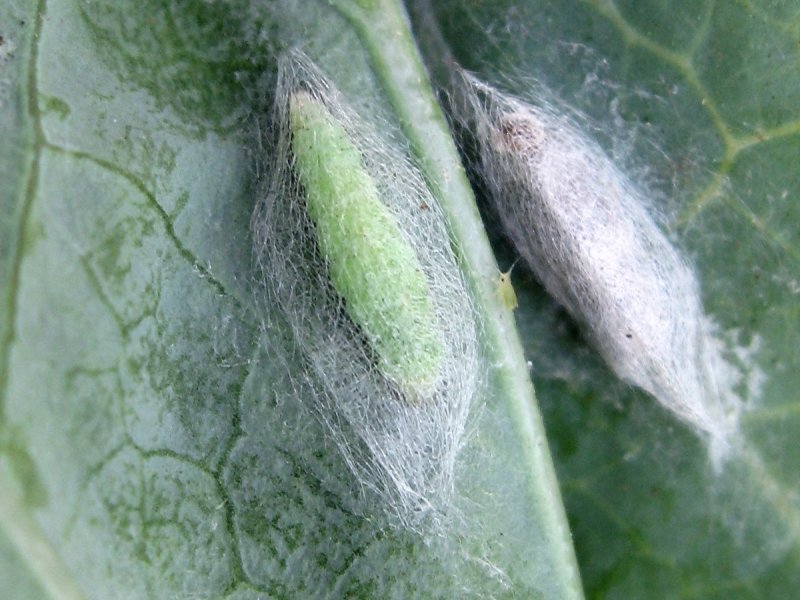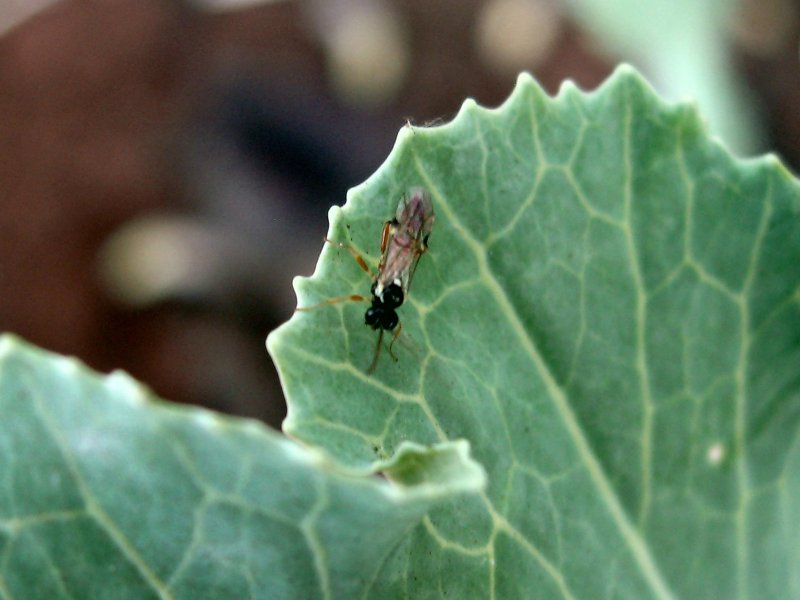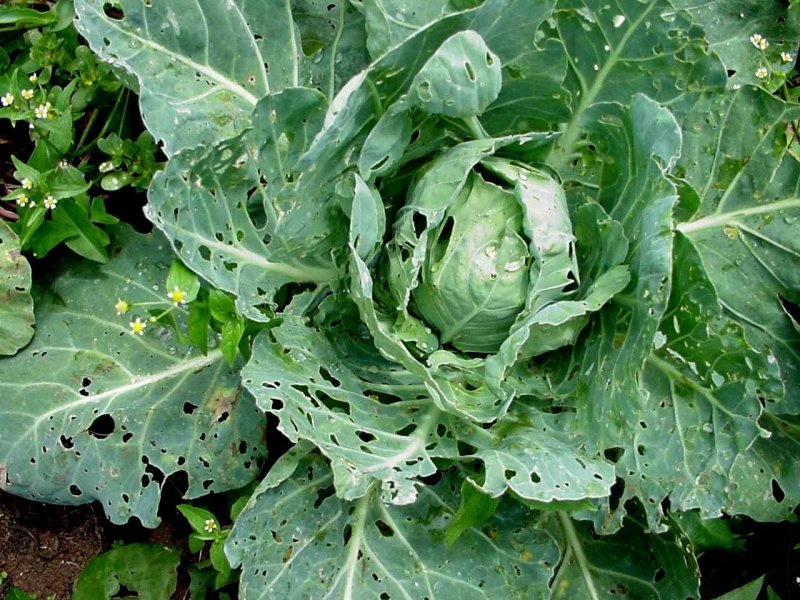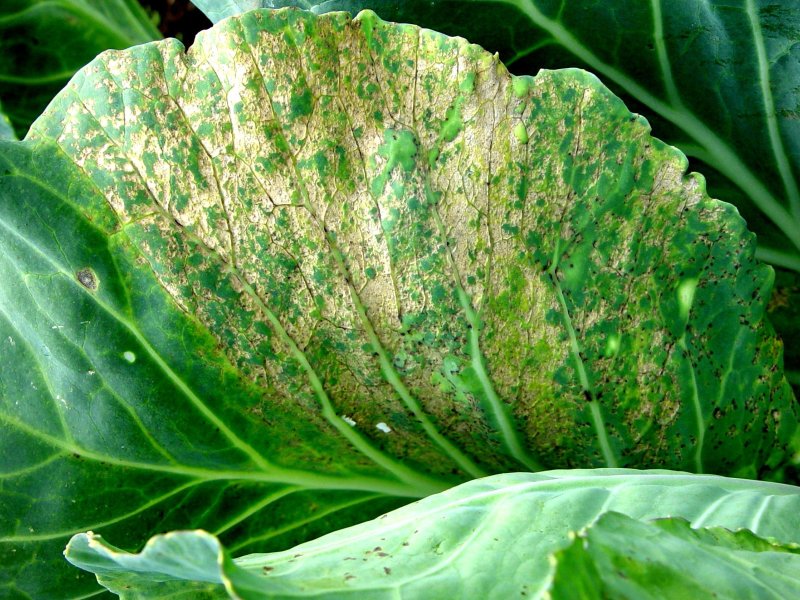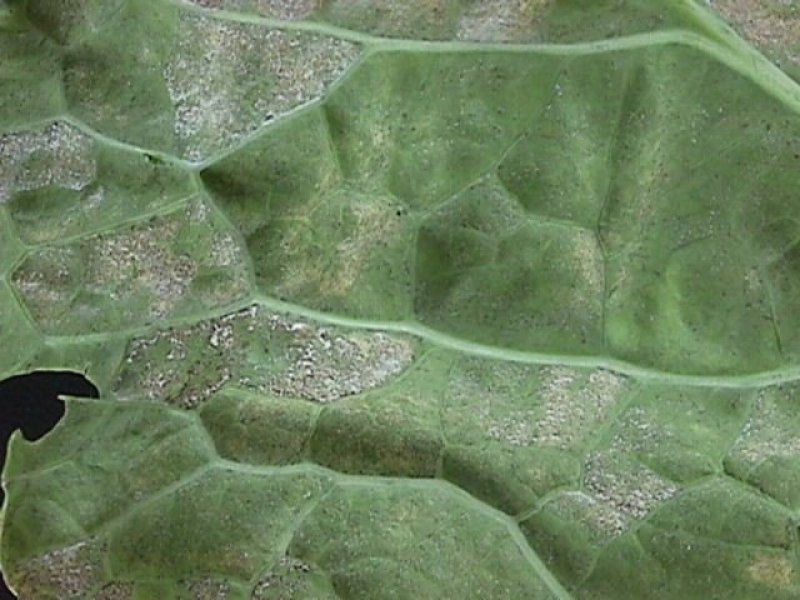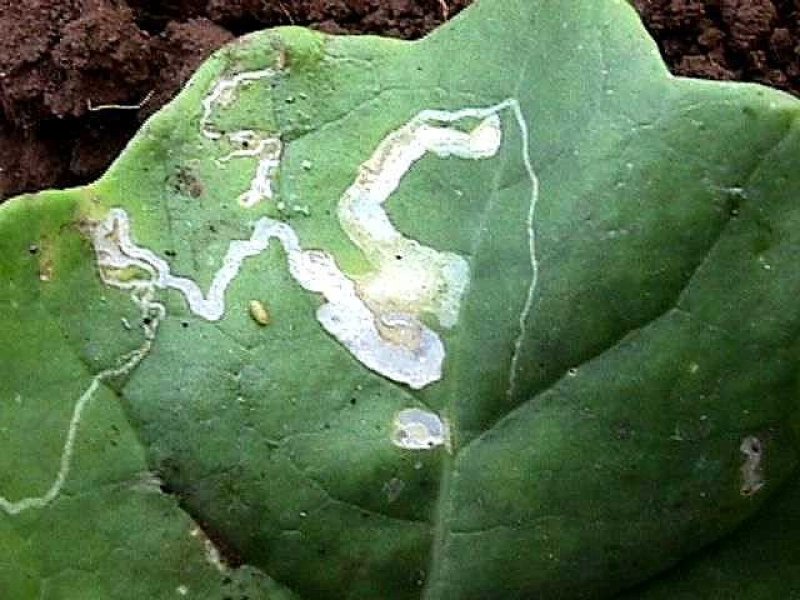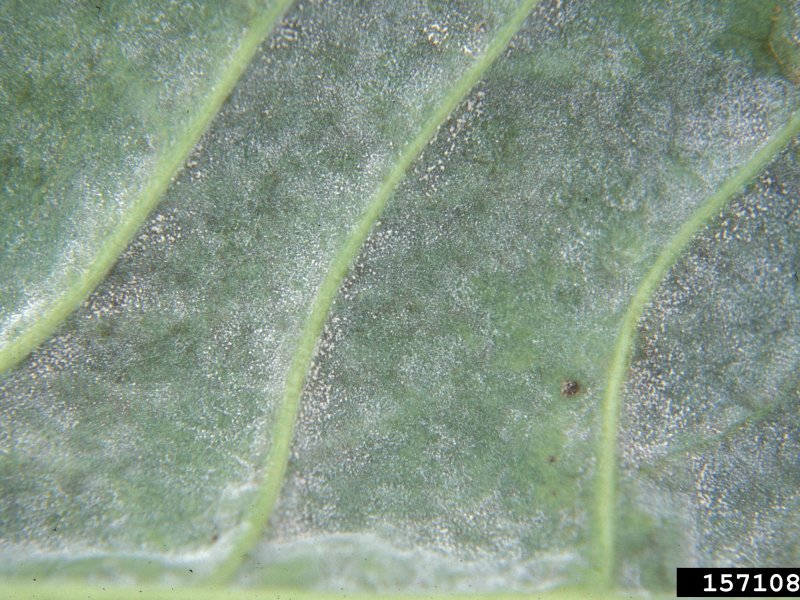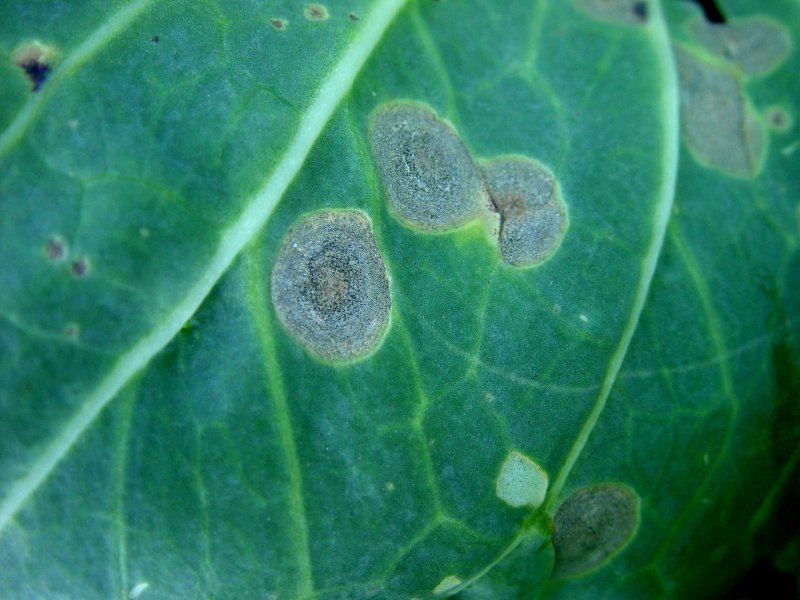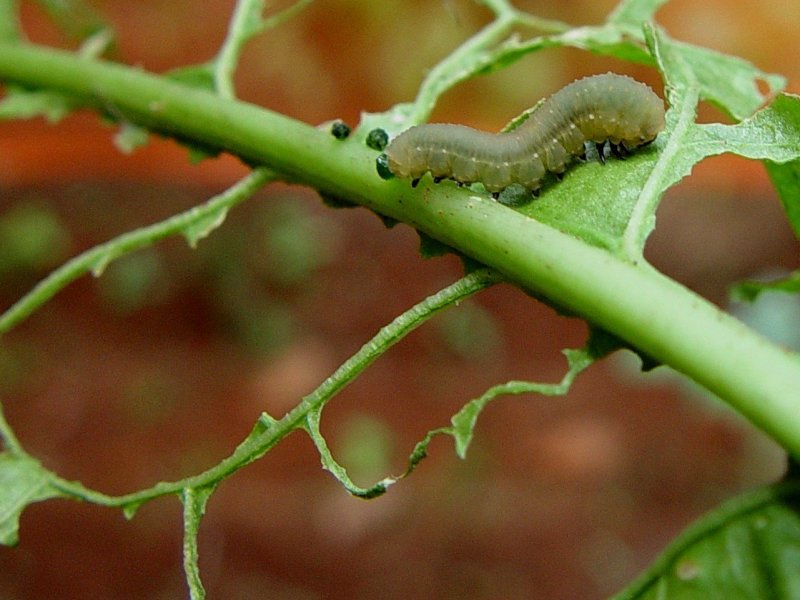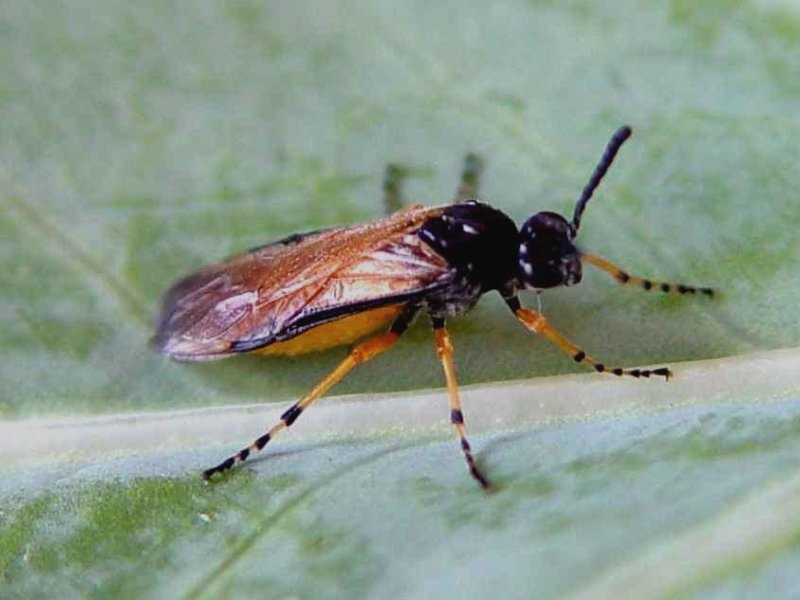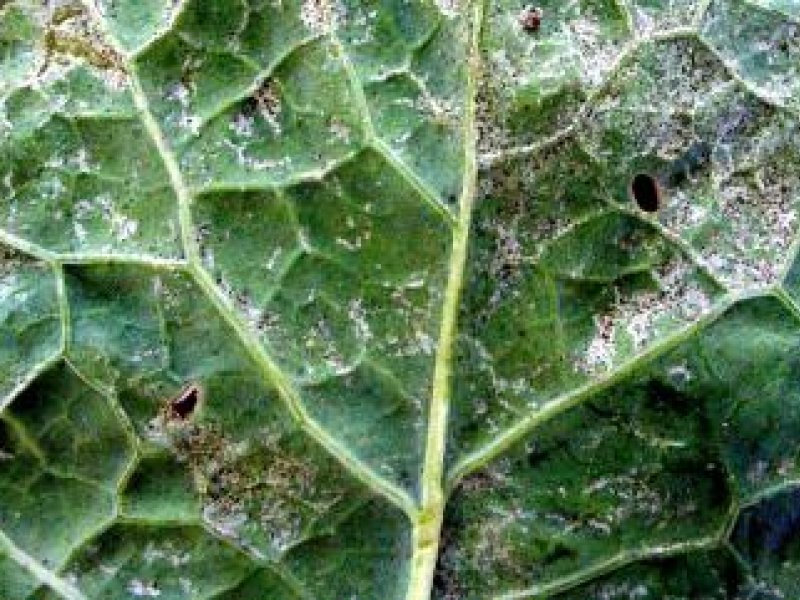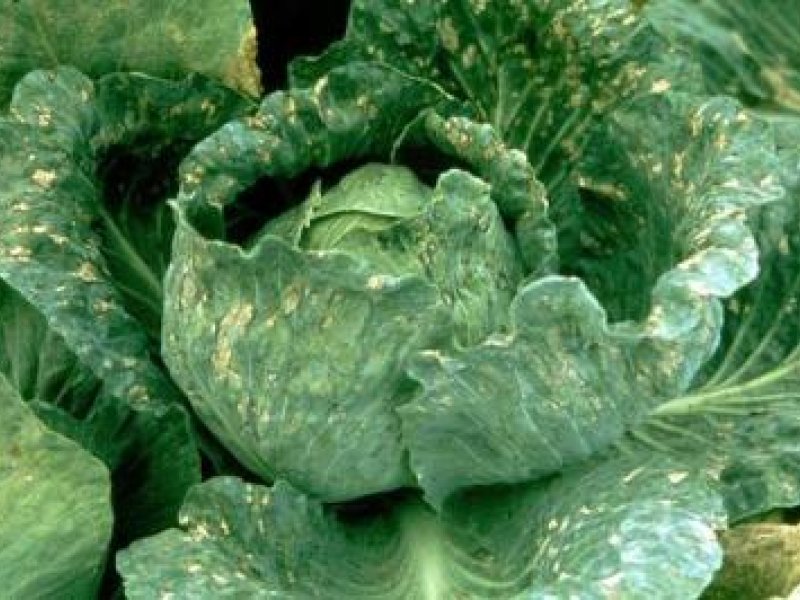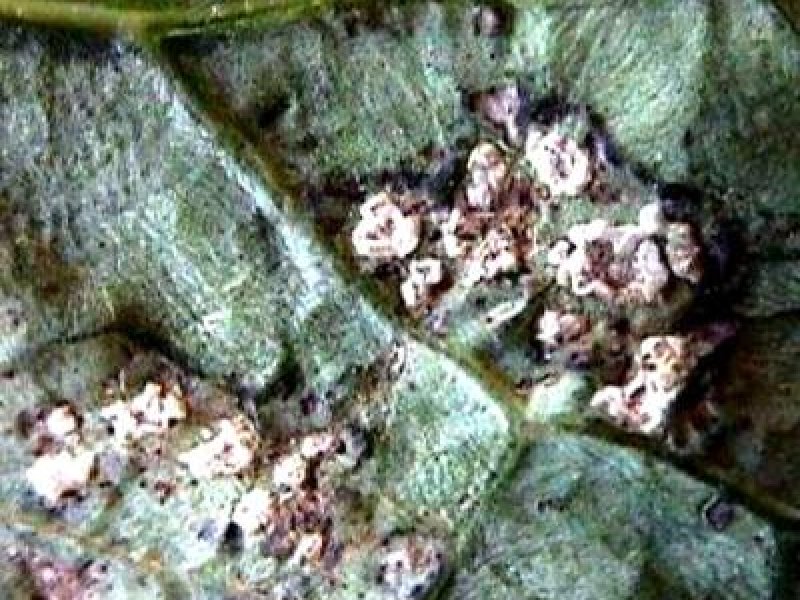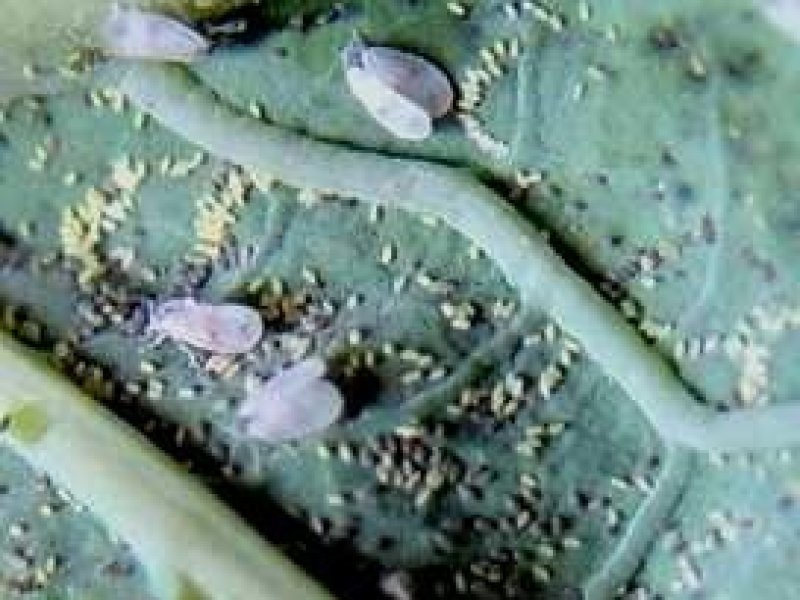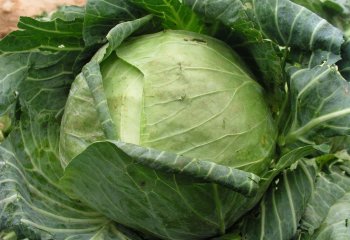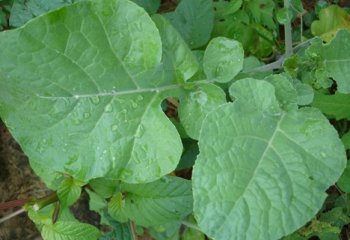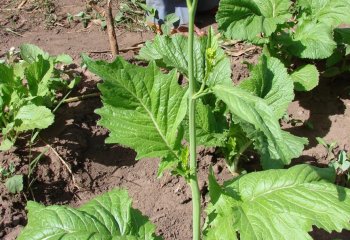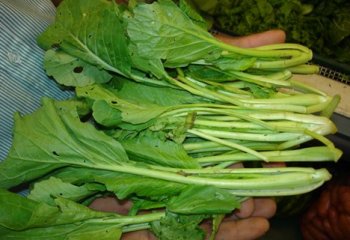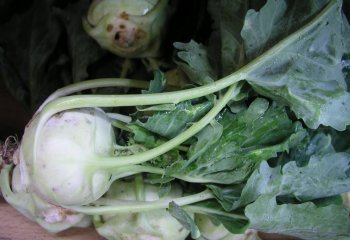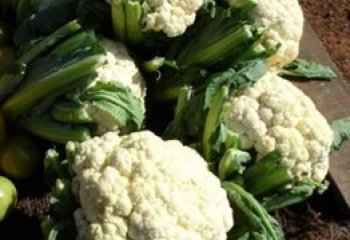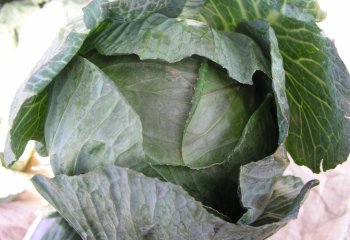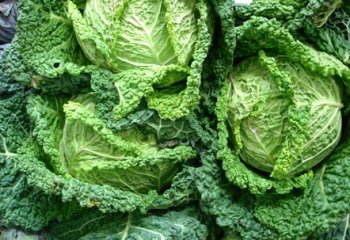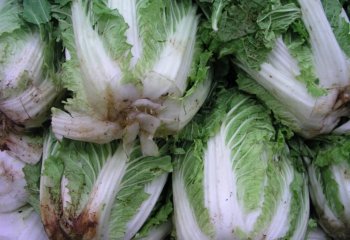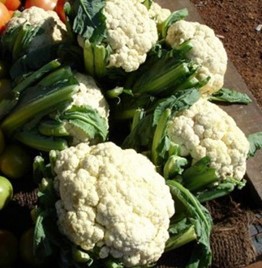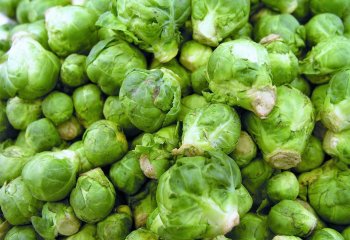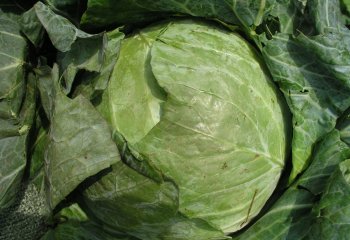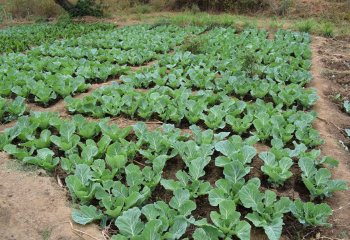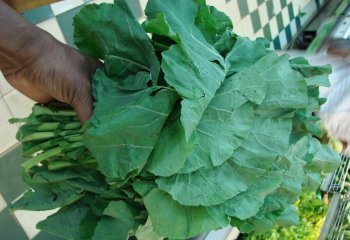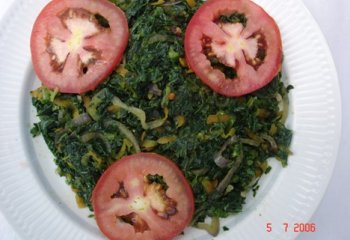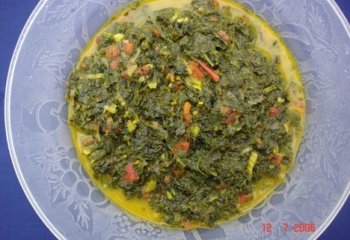|
Alternaria leaf spot (Alternaria brassicae) Alternaria leaf spot or black spot is caused by the fungus Alternaria brassicae. The disease can severely damage cabbage if uncontrolled. The initial symptoms are small, circular, dark spots on older leaf surfaces. As the spots enlarge, concentric rings develop within lesions surrounded by a yellow halo. The tan-coloured centres of lesions may eventually fall out, producing a hole, or under wet conditions, may become covered with masses of black spores. In storage, spots enlarge and soft-rot bacteria may enter lesions. The pathogen can over-season on crop debris. Weeds from the family Cruciferae may also harbour the fungus. Spores of Alternaria can be spread by wind and water. The disease is most damaging under wet, warm (20-30.5 degC) conditions. |
|
|
What to do:
|
|
Aphids Several species of aphids attack brassicas in East Africa: The cabbage aphid (Brevicoryne brassicae) The false cabbage aphid (Lipaphis erysimi) The green peach aphid (Myzus persicae) In particular the cabbage aphid is a major pest in the region. Cool, dry weather is most favourable for aphid development. Large numbers of aphids may kill small plants. Their feeding can distort leaves of older plants and causes leaf curl. Often, the most serious problem associated with aphids is virus transmission. The cabbage aphid and the false cabbage aphid are vectors of virus diseases such as cabbage black ring spot, cabbage ring necrosis, and mosaic diseases of cauliflower, radish and turnip. |
|
|
What to do:
|
|
Bacterial soft rot (Erwinia carotovora var. carotovora) Bacterial soft rot is caused by Erwinia carotovora var. carotovora. It is quite common on Chinese cabbage in the field. On cabbage, turnip and rutabaga the disease may be found in the field, but is most severe during storage. On cabbage, an initial infection occurs on the outer petiole (leafstalk) which is in contact with the soil, and then progresses to its head. An infected head is watery and often has a complete head rot. The affected area becomes soft and mushy and generally turns dark in colour. Soft rot infection on crucifers almost always emits a foul odour. Eventually the leaves, sterns and roots are entirely decayed by the bacteria. The bacterium is spread in the field by water splashes or contact with tools such as hoes or knives. If contaminated knives are used to harvest cabbages, the stored crop may also rot quickly. |
|
|
What to do:
|
|
Bagrada bug (Bagrada hilaris) It is typically shield-shaped, 5-7mm long and 3-4mm wide. The upper surface has a mixture of black, white and orange markings. Feeding by sucking by both adults and nymphs causes damage to leaves, which wilt later and dry. A heavy attack on young plants generally results in death of the plant. |
|
|
What to do:
|
|
Black leg It is serious cabbage disease caused by the fungus Leptosphaeria maculans (Phoma lingam). Symptoms of black leg usually appear as oval, sunken, light brown cankers, often with a black or purple margin, near the base of the stem. The canker enlarges until the stem is girdled and the plant wilts and dies. Severely infected plants are stunted. Infected plants eventually wilt and then turn dull blue-red. With black leg, plants may suddenly collapse due to stem deterioration.
Host range: It includes most of crucifers, but with varying degrees of susceptibility. Most susceptible: cabbages, Swedes, kohlrabi and white mustard. Medium susceptible: cauliflower, turnip, broccoli, rape, kale and collards. Resistant: horseradish, winter-cress, shepherd's purse and pepper grass.
Symptoms: All above parts of a plant may be affected from seedbed to harvest.
Seedlings: Cotyledon infection causes seedlings to die early. This is often overlooked in the seedbed. Stems: An elongated, light brown, sunken spot or lesion with purplish margin forms on stems near the soil line. Lesions gradually extend upward and downward and eventually girdle the stem and the stem turns black. Small, black dots (fruiting bodies of the fungus: pycnidia) appear on the affected area. Internally, the affected stem shows a brown, dry rot. Affected plants often wilt suddenly and die or topple over later as the heads in case of cabbages enlarge.
Leaves: Inconspicuous, circular, light brown to grayish spots form on leaves. The spots soon become well defined and develop ash-gray centres in which large number of minute black bodies (pycnidia) are scattered. The presence of pycnidia on cotyledons, leaves and stems distiguishes blackleg from other crucifer diseases. |
|
|
What to do:
|
|
Black rot (Xanthomonas campestris pv. campestris) Black rot is caused by the bacterium Xanthomonas campestris pv. campestris, and is one of the most serious cabbage diseases in warm climates. The black rot bacterium can over-season on infected cabbage seeds, in weeds from the family Cruciferae (including: black mustard, field mustard, wild turnip, wild radish, shepherd's purse, and pepperweed); or in infected plant material in the soil. |
|
|
What to do:
|
|
Cabbage looper (Trichoplusia ni) The cabbage looper is a green caterpillar with faint white stripes along the body. Caterpillars are about 3.5 to 4 cm long when fully-grown. As they move, they arch their back in a looping fashion, hence the common name looper. Larvae (caterpillars) chew holes in the leaves, and larger caterpillars consume great amounts of plant material. On cabbage they eat into the heads, reducing the marketability of the produce.
The adult is a moth about 2.5 cm in length and mottled, greyish-brown. |
|
|
What to do:
|
|
Cabbage moth (Crocidolomia pavonana (=binotalis)) Cabbage moth larva: when fully grown is about 1.6-1.9 cm long. Larvae pupate in the soil. The pupal stage lasts about 10 days. It is primarily a pest of brassicas and is occasionally an important pest of cabbage and kales. Caterpillars are found in groups. Young caterpillars chew off top leaf surfaces, while older caterpillars feed under a web of silk on young leaves, petioles and growing point of the plant, often damaging it entirely. |
|
|
What to do:
|
|
Cabbage webworm (Hellula undalis) Caterpillars are 1.5 cm when fully-grown, creamy-white in colour with brown stripes along the body and a brown head. Caterpillars feed on leaves, petioles, growing points, and stems.
|
|
|
What to do:
|
|
Cauliflower Mosaic Virus (CaMV) It shows systemic symptoms such as a clearing along the leaf veins (vein clearing). This often is seen first at the base of a leaf. Later symptoms appear as dark green areas along veins (vein banding) and necrotic spotting of the leaf. Chinese cabbage is particularly susceptible to CaMV. In addition to vein clearing a striking mosaic may develop with light and dark green areas seen on the leaves. Plants can be stunted. The main source of CaMV are plants of an infected brassica crop or cruciferous weeds on which a vector has over-seasoned. The virus is transmitted by many species of aphids, such as the cabbage aphid. |
|
|
What to do:
|
|
Cercospora leafspots (Cercospora brassicicola) Cercospora leaf spots is caused by the fungus Cercospora brassicicola. Leafspots vary in colour from pale green to white and generally are bordered by brown tissue. They may be circular or appear angular. Severely affected plants may become defoliated. This disease is not economically important in the East African region. |
|
|
What to do:
|
|
Clubroot (Plasmodiophora brassicae) Clubroot caused by the slime mould fungus Plasmodiophora brassicae is particularly serious in Malawi. Its distinctive symptom is an abnormal enlargement of roots or even the underground stem. Its development is favoured by wet, cool, acidic soils. |
|
|
What to do:
|
|
Cottony rot (Sclerotinia sclerotiorum) Sclerotinia sclerotiorum is a fungus which can survive on infected tissues, in the soil, and on living plants. It causes white mold on cabbage, soybeans, green beans, sunflowers, canola, and peanuts. S. sclerotiorum affects young seedlings, mature plants, and fruit in the field or in storage. Cottony rot begins as tan, water-soaked, circular areas, which become covered by white, cottony fungal growth. As the disease progresses, the host tissue becomes soft and watery. The fungus eventually colonizes the entire cabbage head and produces large, black, seed like structures called sclerotia on the diseased tissue. Plants with root infection often wilt and die prematurely. |
|
|
What to do:
|
|
Cutworms (Agrotis spp) Cutworms cut the stem of plants below the soil surface. The damaged plant wilts and withers. First instars are 0.7-1 cm, later instars are 3.5-5 cm long. |
|
|
What to do:
|
|
Damping-off diseases (Pythium spp., Rhizoctonia solani, Fusarium spp.) In crucifers, several fungi (e.g. Pythium spp., Rhizoctonia solani, Fusarium spp.) can cause damping-off diseases.
Characteristic is wirestem of seedlings caused by Rhizoctonia solani in the seedbed, bottom rot and head rot in the field, and storage and root rot of horseradish, radish, rutabaga and turnip.
Damping-off diseases are favoured by cool, wet soil conditions. |
|
|
What to do:
|
|
Diamondback moth (DBM) (Plutella xylostella) It is a serious pest of brassicas and attacks all Brassica species. A full grown diamondback caterpillar is about 1 cm long.
|
|
|
What to do:
|
|
Downy mildew on cabbage (Peronospora parasitica) Downy mildew is caused by a fungus which mainly attacks foliage. It is responsible for substantial losses in seedling production, especially during the cooler months. Young cabbage plants are more susceptible than older plants. The powdery white spores are the major means of dispersal of the fungus, especially once it is established within seedlings crops. Spores are produced overnight and released the following morning as the air dries out. They are dispersed by wind and rain splash. Downy mildew disease development is favored by cool, moist conditions. Downy mildew disease is first seen as a fluffy or powdery-white mass of spores on the undersurface of brassica seed leaves (cotyledons). This is followed by a black speckling and puckering of the upper surface. Leaves prematurely yellow and fall from the plants. Symptoms on mature plants in the field are generally confined to the leaves closest to the ground. The fungus produces spores on the under surface, and brown to black, sunken, angular, pepper-like lesions on the upper surface of leaves. The fungus can cause black lesions on cabbage heads and breakdown of cauliflower curds in storage. |
|
|
What to do:
|
|
Leafmining flies (Lyriomiza brassicae) Leafmining flies are small about 1.3-1.6 mm in length. Maggots of leafmining flies cause mines while feeding within the leaf. Small, individual leafminers do not produce much damage, but when larvae occur in large numbers, entire leaves can be eaten out. Heavy attacks weaken seedlings and may result in dying off the young plants. |
|
|
What to do:
|
|
Powdery mildew (Erysiphe polygoni) Powdery mildew is a fungal disease which appears as white, powdery spots that may form on both surfaces of leaves, on shoots, and sometimes on flowers and fruit. These spots gradually spread over a large area of the leaves and stems. Leaves infected with powdery mildew may gradually turn completely yellow, die, and fall off, which exposes cabbage head to sunburn. |
|
|
What to do:
|
|
Ring spots (Mycosphaerella brassicicola) Ring spots are small, purple spots surrounded by a ring of water-soaked tissue on leaves which mature to brown spots with olive green borders 1-2 cm wide. The spots may develop numerous fruiting bodies which give them a black appearance or develop a concentric pattern. Heavily infected leaves may dry up and curl inwards. Ring spot requires cool, moist conditions to develop. |
|
|
What to do:
|
|
Sawflies (Athalia spp) Sawflies are sporadic but serious pests of brassicas. The cabbage sawfly (Athalia sjostedti) has been reported as a major pest in Tanzania. Sawfly adults are wasps with dark head and thorax, bright yellow abdomen, and two pairs of membranous wings. They are about 1 cm long. Eggs are laid singly inside the leaf. Larvae are oily, black or greenish in colour with a swollen part just behind the head, which makes them appear humped. They look very similar to caterpillars, but they have 6 to 9 pairs of prolegs (abdominal legs), whilst caterpillars have 5 pairs or less. Larvae measure up to 2 cm when fully grown. Larvae eat the blades of leaves leaving just the main veins. They drop from the plant to pupate in the soil.
|
|
|
What to do:
|
|
Thrips (Thrips tabaci Frankliniella spp) Thrips feeding on cabbage cause rough bronzed blisters on leaves inside the cabbage head. hey are less than 2 mm long. Thrips attacks are not common on brassicas in the eastern and southern Africa region. |
|
|
What to do:
|
|
Turnip mosaic virus (TuMV) The first symptoms to develop when Brassica seedlings are inoculated with TuMV are chlorotic spots on inoculated leaves, mottling followed by systemic vein clearing, mosaic and/or necrosis, leaf distortion and often stunting. |
|
|
What to do:
|
|
White rust (Albugo candida) It affects every known cruciferous crop. However, this disease is generally less common on cabbage, Brussels sprouts, broccoli and cauliflower than on radish, horseradish, mustard and turnip. Leaves have chlorotic or necrotic spots on their upper surface. Pustules form on the lower side of the leaves, small stems and floral parts. |
|
|
What to do:
|
|
Whiteflies (Bemisia tabaci, Trialeurodes vaporariorum and Aleyrodes proletella) Whiteflies feed on brassicas. Adult whiteflies are about 1 mm long. In East Africa whitefly populations on brassicas usually do not build up to such an extent that control measures are required. |
|
|
What to do:
|
Geographical Distribution in Africa
<i>Brassica oleracea</i> geographical distribution map © OpenStreetMap contributors, © OpenMapTiles, GBIF.
Geographical Distribution of Cabbage/Kale in Africa. Updated on 8 July 2019. Source FAOSTAT
General Information and Agronomic Aspects
Introduction
The genus Brassica belongs to the family Brassicaceae. The genus consists of around 37 species. Members of the genus are informally known as cruciferous vegetables, cabbages, or mustard plants. Some of the notable economically significant species within the genus include: Brassica carinata (Ethiopian rape, Ethiopian kale or Ethiopian mustard), B. juncea (Chinese mustard, Indian mustard ), B. oleracea (cabbage, broccoli, cauliflower, kale, Brussels sprouts, collard greens, Savoy cabbage, kohlrabi and gai lan), B. napus (Rapeseed) and B. rapa (Synonym: Brassica campestris) (turnip, napa cabbage or Chinese cabbage, bok choy etc.).
Ⓒ Adeka et al., 2005
© Maundu, 2006
© Maundu, 2007
© Maundu et al. 2007
Related Groups
1. Brassica oleracea (Acephala Group)- Sukuma wiki (Swahili), Chomolia
2. Brassica oleracea (Botrytis Group)- Cauliflower
3. Brassica oleracea (Gemmifera Group)- Brussels sprouts
4. Brassica oleracea (Italica Group) Broccoli; Asparagus Broccoli; Calabrese; Calabrese Broccoli; Sprouting Broccoli
5. Brassica oleracea (Gongylodes Group): Kohlrabi
6. Brassica oleracea (Tronchuda Group): low-growing annuals with spreading leaves such as Portuguese cabbage).
Brassica olearacea is one of the most important foods crops in the world. The wild uncultivated form of Brassica oleracea is known as wild cabbage and has its natural occurrence in South Europe where it is found in limestone sea cliffs, tolerating salt and lime conditions. Due to its long cultivation, many cultivars of Brassica oleracea exist including the cabbage, broccoli, cauliflower, Brussels sprouts and many others. These fall in about seven or eight groups (depending on the author) based on the development of the plant. Important ones for the region include:
• Acephala Group: These are non-heading cultivars including kale, collards and tree cabbage. This group is closest to the wild form.
• Capitata Group: Cultivars in this croup have a head like cabbage (white cabbage, savoy cabbage and red cabbage).
• Botrytis Group: Cultivars in this group form compact inflorescences and include cauliflower.
• Italica Group: (Some treat this as part of the Botrytis Group): Cultivars in this group also form compact inflorescences and include broccoli, asparagus broccoli and calabrese broccoli.
• Gemmifera Group: bud-producing cultivars including Brussels sprouts
• Gongylodes Group: turnip-like cultivars such as kohlrabi
• Tronchuda Group: low-growing annuals with spreading leaves such as Portuguese cabbage.
• Alboglabra Group: - In this group is kai-lan (Chinese broccoli or Chinese kale)
Adeka et al., 2007
Members of Brassica oleracea are widely distributed throughout the world, from the tropics to temperate regions with cool climates. In the tropics they are particularly important in highland areas with moderate rainfall. While many of the members are grown for commercial purpose in Africa, the cabbage is also extensively grown for household use. It is adaptable to a wide range of soil types but prefers well drained fertile soils. Cabbage plants require full sunlight for optimal growth. They are good sources of essential nutrients, including vitamins C and K, dietary fiber, and antioxidants. The vegetable is commonly consumed in various culinary preparations, such as soups, stews, salads, and stir-fries. It can be cooked, pickled, or fermented to enhance its flavors and extend its shelf life. (Source: Van der Vossen.& Seif, 2004, GBIF secretariat, 2021, The North Carolina Extension (https://plants.ces.ncsu.edu/), Royal Botanic Gardens, Kew).
© Pankaj Oudhia (Courtesy of EcoPort, www.ecoport.org
These vegetables are grown mainly for the local market. They are valuable as sources of vitamins and minerals, as well as a source of cash for smallscale farmers in rural and peri-urban areas. However, production is often constrained by damage caused by a range of pests (insects, diseases, nematodes and weeds).The range of pests attacking the different brassicas is similar, but the relative importance of individual pest species varies between the different crops. Cabbage is mainly sold fresh or as processed canned product. Processed products include those that are treated in vinegar, or fermented such as sauerkraut or kimchi. Fresh cut or lightly processed products include coleslaw and ready-to-eat salad mixes that contain shredded cabbage. Consumers generally prefer fresh green cabbage, when available, to stored cabbage. Much of the stored cabbage is grown for processing.
Species account
The main brassicas grown in the region include:
Cabbage (Brassica oleracea (Capitata Group)) commonly referred as the headed cabbage is cultivated in various regions worldwide, including Europe, Asia, and the Americas. It is a cool-season crop that thrives in temperate climates or highland zones with moderate sunlight and well-drained soil.
Cabbage is a biennial plant with a short stem and a cluster of thick, overlapping leaves forming a round or elongated head. The leaves have a range of colors including white, green and red. The inner leaves are usually more tender and paler in color.
Headed cabbage is classified into different varieties: white-headed cabbage (smooth white to green leaves), red-headed cabbage (red leaves), and savoy-headed cabbage (curly green leaves). Cabbage is usually consumed as a cooked or stir-fried vegetable, fresh as salads and is sometimes pickled. It is low in calories, rich in vitamins C, K, and B6, and packed with dietary fiber and antioxidants. Cabbage exhibits variations in head shape, size, leaf color, texture, maturity, flavor, and culinary uses (Van der Vossen.& Seif, 2004, GBIF secretariat, 2021, Schoch CL, et al., 2020).
Ⓒ Maundu, 2005
© Maundu et al., 2006
© Maundu, 2006
Chinese cabbage belongs to a different species, Brassica rapa (Synonym: Brassica campestris, B. chinensis, B. pekinensis). It is a leafy vegetable with elongated, cylindrical leaves forming a compact head. It is native to East Asia, particularly China and Korea but has now spread to the rest of the world including African countries. It is quite popular in Southern Africa. Chinese cabbage thrives in temperate climates and prefers well-drained soil and moderate amount of sunlight to grow optimally. The crop is widely consumed in various countries and comes in two main types: chinensis (with dark green leaves white petioles and more robust flavor often used in stir-fries and soups) and pekinensis commonly known as Napa cabbage (pale green leaves with a white stalk with milder taste commonly used in salads).
Within each type, there are various cultivars that exhibit differences in size, shape, leaf texture, and taste. Some cultivars have been specifically developed for early maturity or improved disease resistance, catering to specific growing conditions and consumer preferences (see Okamoto, et al., 2021 for more information).
Ⓒ Adeka et al., 2005.
Related Brassica oleracea species
Kale- (Brassica oleracea (Acephala Group) - also known as collard or Sukuma wiki, is a leafy plant with no central head like cabbage. It forms loose clusters of nutritious dark green, broad. The leaves are smooth or slightly wrinkled, with a thick, fibrous texture. The plant can reach a height of 2-3 feet and develops a sturdy stem and adapt well to different climates and soil conditions, making it a versatile crop.
The dark green leaves are commonly steamed, sautéed or stir fried and used as a side dish consumed along starchy foods. Kales are rich in vitamins A, C, and K, as well as folate, calcium, potassium, and fiber. Kale is also a great source of antioxidants and contains compounds with potential health benefits.
There are several cultivars of kale, each with its unique characteristics. Some popular varieties include curly kale, which has tightly curled leaves; Tuscan kale (also known as Lacinato or dinosaur kale), which has dark blue-green leaves with a bumpy texture; and red Russian kale, which features purplish-red veins and a sweeter taste. These cultivars offer a range of flavors, textures, and visual appeal, allowing for culinary creativity and diversity (specialtyproduce.com, ncsu.edu, Poveda et al., 2020).
Ⓒ Adeka et al, 2005
Cauliflower (Brassica oleracea (Botrytis Group)) is a versatile plant with a stout stem, large green leaves, and a tightly packed head made of flower buds. It grows to a height of 30-80 cm and only the edible white flesh, known as "curd," is consumed. Cauliflower is rich in Vitamins C and K and is commonly cooked or used raw in salads and relishes.
This plant thrives in cool and temperate climates, preferring well-drained soil with organic matter. Consistent moisture is necessary, while extreme temperatures can be detrimental. Adequate sunlight is crucial for developing a compact head. Originally from the Mediterranean region, cauliflower is now grown worldwide, including Europe, North America, Asia, and Africa. Prominent cauliflower cultivators in Africa include Morocco, Egypt, South Africa, and Kenya, while other African countries often import cauliflower.
Cauliflower exhibits a range of appearances and colors due to different varieties and cultivars. Alongside the traditional white cauliflower, there are orange, green, and purple varieties. These variations arise from natural mutations or selective breeding to enhance taste, nutritional content, or visual appeal (Tjeertes, P., 2004.SANBI, n.d).
© Pankaj Oudhia (Courtesy of EcoPort, www.ecoport.org)
Broccoli (Brassica oleracea (Italica Group)) is an annual plant that grows upright and can reach a height of 2-3 feet (60-90 cm). It has a big flowering head and small dark leaves at the base, which can be eaten as a vegetable. The main head of broccoli is made up of many small, tightly packed florets that are usually bluish-green but turn yellow as they mature. There are also purple or white varieties of broccoli. Broccoli is grown and consumed worldwide, especially in Europe, North America, and Asia. In Africa, its consumption is increasing in urban areas where it is more readily available, with countries like South Africa, Kenya, and Egypt seeing a growth in broccoli consumption.
Broccoli florets and stems can be cooked in various ways, such as steaming, boiling, stir-frying, roasting, or even eaten raw. It is commonly used in dishes like stir-fries, pasta, soups, salads, and casseroles. Broccoli complements different flavors and ingredients, including garlic, lemon, olive oil, cheese, and spices. Apart from its versatility in cooking, broccoli is also highly nutritious. It is low in calories, high in fiber, and a great choice for a healthy diet. It contains valuable vitamins C and K, folate, as well as minerals like potassium and iron. Broccoli is also packed with antioxidants and phytochemicals, which have been linked to various health benefits, including a reduced risk of certain types of cancer (PlantVillage, n.d. specialtyproduce.com)
Ⓒ Adeka et al., 2005
Brussels sprouts (Brassica oleracea (Gemmifera Group) is a small vegetable, each piece resembling a miniature cabbage. They are grown for their edible buds, which grow in a spiral pattern along the stem. Originally cultivated in Europe, particularly in Belgium, the Netherlands, and the United Kingdom, Brussels sprouts are now grown in other parts of the world, including North America, Australia, and parts of Asia. While not as widely consumed in Africa compared to other continents, Brussels sprouts are gaining popularity in certain regions.
Brussels sprouts are rich in fiber, vitamins C and K, and contain significant amounts of iron and minerals like potassium. They can be prepared by steaming, boiling, roasting, or stir-frying. When cooked, their distinct slightly bitter flavor becomes milder. They complement various ingredients and seasonings and are commonly enjoyed as a side dish or added to salads, soups, and stir-fries (Tjeertes, P., 2004, specialtyproduce.com).
Seeds of the varieties given below are readily available from commercial seed companies. The ones below are available from vendors in Kenya.
Ⓒ Adeka et al., 2005
Cabbage varieties
Variety name |
Characteristics. |
Globe Master F1 Hybrid" |
-High yielding hybrid cabbage with wide adaptability to different conditions. -Has a nice blue green colour and globe shaped with short core. -Highly tolerant to black rot and Fusarium yellows. -Grows up to 2.5 kg 75 days after transplanting -Can grow up to 3.5 kg under optimum conditions, especially in warm areas. |
Gloria F1 Hybrid" |
-Proven best F1 hybrid in fresh market and processing industry. -Well adaptable to various climatic conditions withstanding high temperatures. -Mid-early maturing variety, ready for harvesting in 90 days after transplanting. -Head weighs about 4 kg with solid blue green colour and thick waxy layer . -Has strong rooting, medium resistance to Fusarium yellows. -Has good resistance to splitting and keeps well after harvesting. |
Blue Dynasty F1":
|
-Adapted to a wide range of agro ecological zones. -Heat tolerant. -Maturity is about 80-85 days after planting. -Head weight is about 4-6 kg of blue green color. -Yield potential is about is 45-68 t/acre. -Resistant to black rot, ring rot and diamondback moth. -Has a good transport quality. |
"Victoria F1" |
-It is widely accepted in various markets. -Very fast growing with maturity period about 70-75 days from transplanting. -It uniformly matures. -Has compact heads each weighing between 4-5 kg. -Its yield potential of about 45-56 t/acre. -It transports well |
"Oxylus F1" |
-Adapted to a wide range of ago ecological zones. -It has compact heads weighing about 4-5 kg each. -Yield potential ranges from 45 to 56 t/acre. -Its maturing period is about 70-75 days -from transplanting and matures uniformly. -It is heat resistant and also resistant to alkalinity. -It transports well. |
Green (Brassica oleracea var. capitata), (Brassica oleracea var. capitata)-, F1 Hybrid" |
-Medium-large, semi-upright plant grows well in medium hot to cold areas -Has deep green, oblate head growing up to 4 kg under optimum conditions. -Medium-early in maturity and takes about 75-80 days after transplanting. -Has excellent field holding capacity and will last long in the field before bursting. |
Riana F1 Hybrid" |
-An all-round variety that is heat and cold tolerant. -It produces round, blue-green compact heads weighing about 2.5 kg. -Does well both in temperate, subtropical and tropical zones. -Tolerant against black rot and tip burn. -Matures in 90-100 days after transplanting -Has excellent non-bursting quality round head after maturity. |
Super Master F1" |
-Widely adaptable hybrid, produces round to flat-round, bluish green compact head weighing 4-5 kg. -It has an excellent field holding capacity and can stand in the field for long without bursting. Matures in about 80-85 days after transplanting. -Resistant to Fusarium yellows, Alternaria, medium to high resistance to black rot and diamondback moth. |
Santar F1" |
-It has a very firm compact, globe-shaped head, which is blue green in color. -The weight is 4-6 kg. -It matures in 80-90 days after transplanting. -It has good resistance especially to black rot and diamondback moth. -It has good transportation ability |
Field Winner F1 Hybrid"
|
-takes about 80 days from transplanting to harvest. -Head is semi-flat and weighs about 4 kg. -It is resistant to black rot. -It has a sweet taste. |
"CPI"
|
-It is a hybrid cabbage with green heads. -Round shape and weighs 3-5 kg. -Matures in 70-80 days after transplanting. -It has a good field holding capacity since it does not burst easily. -Has a sweet flavor, very ideal for salads. -It is tolerant to Fusarium and black rot. |
Pruktor F1 Hybrid" |
-Takes about 80 days from transplanting to harvest. -Head is high and round. -It has high resistance to black rot. -Has shown considerable resistance to diamondback moth. |
Red Dynasty F1" |
-High in anthocyanin with compact heads weighing about 4-5 kg each. - Yield potential ranges from 45 to 56 t/acre. -Early maturing taking about 70-75 days from transplanting. -Resistant to black rot and diamondback moth. -Transports well. |
Ruby Perfection F1 Hybrid" |
-Vigorous, easy growing and heavy yielder with a deep red head weighing about 2 kg. -Very uniform maturity, is late busting therefore has a long harvest period. -Strong tolerance against heat and cold with ability to form heads at low temperatures. -Matures in about 80 days after transplanting. |
Copenhagen Market" |
It is open-pollinated. -The most popular amongst the ball-headed cabbages and a great favourite for the both home and market gardeners in Kenya at present. -The heads are uniform round, firm, medium sized and weighing about 2-3 kg. -The plant is short-stemmed and rather small, and can be spaced closer. -It is early maturing, approx. 60-70 days after transplanting. -Rather sensitive to splitting and should not be left in the field for too long after maturity. -Highly dependable and productive variety. |
Glory of Enkhuizen |
-It is open-pollinated. -A nice and attractive variety which is presently more popular in East and Central Africa. -The plant is low and relatively wide. -Heads are medium large, flat round, green, firm and sweet (sweeter than any drumhead type). -Matures after about 12 weeks with the head weighing about 3.5 kg. -Harvesting is spread for about 3 weeks thus market supply can be over a long period. |
"Prize Drumhead"
|
-It is open-pollinated. -A very late maturing variety in about 18-19 weeks. -The heads are flat, solid, largest is about 30 cm in diameter and can weigh more than 5 kg. -Plants are spreading type and very large, -A hardy variety which produces high yields. |
Sugar Loaf" |
-It takes about 75 days from transplanting to harvest. -Head is conical and weighs about 2 kg. -Prefers cool conditions. -Its suitable for areas with well distributed moderate to heavy rainfall. -It should be planted in well drained soils./ |
Chinese cabbage varieties
Variety name |
Characteristics. |
Hero F1 (Sokoni)" |
-Early maturing hybrid, which is ready 65 days after transplanting -High tolerance against some virus diseases and black rot. -It is strong against heat and cold, vigorous and easy growing. -Medium sized green head with excellent internal white colour, weighing 2 kg with good transportation and storage ability. -Suitable for high density planting due to its compact round leaves and standing plant habit. |
Chihili" |
-Open-pollinated Chinese cabbage. -Produces uniform pale green, loaf-like heads, -Grows vigorously and the core is white. -Prone to bolt at low temperature. -Widely adaptable cabbage with a slightly tangy flavour, popularly used in salads. -Over the years the variety has become very popular in Tanzania. |
© Maundu et al., 2007
Broccoli varieties
Variety name |
Characteristics. |
Calabrese" |
-Early broccoli with medium large and compact heads with exquisite flavour. -Abundance of fleshy stalked flowering shoots are produced over a long period. -A nice variety with fine quality. |
"Heritage F1" |
-Ideal for cool climatic zones. -It is dome shaped with lightly beaded florets. -Maturity period is about 80 days from transplanting. -Potential yield is about 8 t/acre. -It has intermediate resistance to downy mildew. |
"Dandy Early No. 32 F1" |
-This is an early, vigorous variety -Tolerant to black rot and downy mildew. -Can withstand high temperatures. -Head is firm, dome-shaped about 10-12 cm wide and 6 cm high. -Matures 92 days after planting and harvesting continues for about 10 days. |
Early Green F1" |
-Early maturing with good quality heads. -It has a typical single head and no side shoots. -The heads are solid, regular shaped. -It is mushroom shaped with uniform bluish green colour. -Heads ripen evenly and harvesting starts 85 days after germination lasting 10-12 days. -Responds well to heavy watering and thrives at high altitudes. |
Cauliflower varieties
Variety name |
Characteristics. |
Snowball |
-Widely adaptable, mid-early variety. -The curd is well covered by straight leaves, head is rather round, firm and white weighing approximately 1 kg. -It is a popular kitchen garden variety. |
"Snow Crown F1 Hybrid"
|
-Very early maturing variety in about 70 days after transplanting. -Plants are medium-upright with excellent curd quality. -The head is white and semi-dome shaped. - High yielder with strong tolerance to heat and cold and a very popular hybrid for its easy growing. -Head weighs about 850 gm. |
"Extra Early Six Weeks"
|
-It takes 65 days from transplanting to harvest. -Head is round and firm. -Average head weight is about 1.2 kg. -It is more exacting in climatic requirements. -High temperatures are not favourable. Soils should be clean and high in organic matter. |
"Kibo Giant"
|
-It takes about 75 days from transplanting to harvest. -Head is snow white, compact and fined grained. -Average head weight is about 1 kg. -It has large wrapper leaves. |
"Fremont F1"
|
-Ideal for cool climatic zones. -Its fast growing with a maturity period of about 90-100 days from transplanting. -It has attractive white colored curd. -Yield potential of 7-9 t/acre. -Average head weight is 600-800 grams. |
"Italian Giant"
|
-Takes 75 days from transplant to harvest. -Has a white, smooth and firm head. --High temperatures are not favorable for its growth. |
Wallaby" |
-It takes 80-85 days to harvest from transplanting. -Head is snow white, compact and fine grained. |
Kale varieties
Variety name |
Characteristics. |
"Thousand Headed" |
Stems are thick with dark green big leaves. Continuous growing and hardy crop Tolerant to cold temperatures Can stay in the field for long time, thus giving higher yield. Matures 90-100 days Can be used as fodder for animals. It is easily digestible and easy to cook. |
Southern Georgia" |
-Very popular seed variety grown across Africa. It has been developed to give high yields while up to 6 months before flowering thus profitable to farmers. -The leaves are well flavored and easy to cook. -It is popular in the local market. -It is adapted to hot areas. -It is hardy and resistant to black rot. |
"Marrow Stem"
|
-Has dark green leaves and flavor and little fibre. -It is vigorous, medium tall with finely curled leaves -less prone to bird damage. |
For information on seed companies contact Horticultural Crops Development Authority. (info@agricultureauthority.go.ke, www.agricultureauthority.go.ke, +254 20 88469)
Ecological information and agronomic aspects on cabbage
Cabbage is a biennial plant that grows best under full sunlight. The optimum mean temperature for growth and quality head development is 15-18°C, with a minimum temperature of 4°C and a maximum 24°C. Generally, young plants are more tolerant to heat and cold than plants nearing maturity. For seed production cabbage plants need to pass through vernalisation: continuous days with temperatures at 1.7-10 °C before they start bolting. Broccoli and cauliflower produce seed without vernalisation. Cabbage grows well on a wide range of soils with adequate moisture and fertility. Soil pH in the range of 6.0-6.5 is preferred, but cabbage will tolerate a soil pH range of 5.5 to 6.8. Cabbage is a heavy feeder, so to get good yields, proper fertilisation is necessary. To maintain growth, cabbage requires a consistent supply of moisture, and should as a general rule receive a minimum of 2.5 cm of water per week. Larger quantities may be required when cabbage is grown on sandy soils or when evapotranspiration is high.
Nutrient deficiencies
Growing healthy plants is the best way of avoiding problems. Healthy plants grow on a healthy and well nourished soil with a good texture. Good compost is the best and most balanced soil and plant feed available to farmers. Regardless of soil type, excessive N (nitrogen) can promote second growth and split heads. A high level of nitrogen will also shorten storage life of cabbage and promote pungent odour (strong smells) during cooking. Combined with high temperatures, excess N (nitrogen) can promote such rapid growth that plants show symptoms of tip burn in susceptible cultivars. Depressed yields, delayed maturity, reduced keeping quality and strong or objectionable flavours are indicative of N deficiency. Like most cruciferous crops, cabbage has a high requirement for boron and molybdenum. Boron deficiency causes yellowing or chlorosis of the youngest leaves and stems, which often starts from the base and extends to the tip, hollow and discoloured inside stems of broccoli and cauliflower, and hollow and/or shrunken roots of turnips. Rosetting or even death of terminal shoots or buds occurs in extreme cases. The common symptoms of molybdenum deficiency in cabbage include a general yellowing, marginal and interveinal chlorosis, marginal necrosis, rolling, scorching and downward curling of margins usually on older leaves. Compost and well rotted animal manures are good sources of most micronutrients including boron and molybdenum.
Land preparation and management
- Prepare land well before transplanting.
- Avoid field operations when it is wet. This will help to prevent inadvertent spread of diseases from plant to plant and movement of infested soil within and outside the field.
- Keep fields free of weeds. Especially weeds of the brassica family are potential alternative hosts of insect pests and diseases and are nutrient competitors.
- Ensure optimal fertilisation. Cabbage has a very shallow root system and is particularly responsive to phosphorus. Where the soil has a low phosphorus content the application of 'Mijingu Rock Phosphate' is recommended.
Propagation and planting Seedlings:
- Practise crop rotation: site seedbeds on land not previously under crucifers, and preferably away from old crucifer fields.
- Use clean wooden trays to raise seedlings, use mixture of compost and top soil or forest soil for raising seedlings.
- Heat soil in the seedbed: place plenty of crop trash or straw and burn for at least 30 min, and after cooling, mix the soil with compost in equal proportions.
- Use certified disease free seed of resistant/tolerant cultivars.
- Mulch seedlings in the seedbed, if possible.
- Do not over water seedlings in the seedbed: water seedlings early in the morning and thin out seedlings to avoid plant congestion in the seedbed. Excessive watering is conducive to damping-off diseases, and extended wetness of seedlings favours development of foliar diseases.
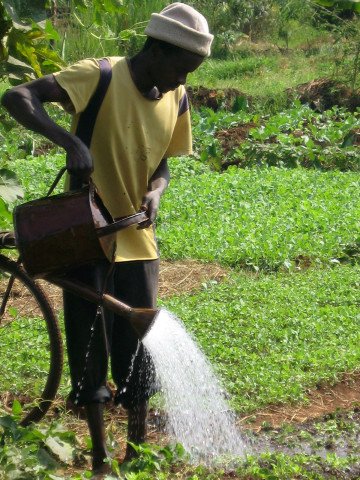
A smallholder farmer watering a kale nursery bed
(c) A. A. Seif
Seeds:
Treating own seed in hot water to prevent seed-borne diseases such as black rot, black leg, black spot and ring spot is recommended where these diseases have previously appeared Hot water treatment of seeds helps reduce the seed-borne pathogens. However, the specified temperature and time interval should be strictly followed in order to maintain seed viability. Use a good thermometer or better ask for assistance from qualified personnel from your local agriculturist office. Recommended temperature and time for hot water treatment for broccoli, cabbage, cauliflower, kale kohlrabi and turnip is 50°C (122 F) for 30 minutes.
For more details on Hot water treatment click here
Husbandry
- Cabbage is often planted on raised beds that are shaped from bare soil after ploughing and disking. This technique is popular on level soils where furrow irrigation is also used. Bed culture is also used in other areas to improve soil drainage or when plastic mulch is used. The trend has been toward increased use of conservation tillage, particularly on steeply-sloping soils prone to erosion. Producing cabbage using conservation tillage reduces the number of field passes by farm equipment, thus reducing compaction, preserving equipment and conserving fuel.
- Conservation tillage systems cause minimum disturbance to the soil after the previous crop has been harvested. Crop residues are left in the field to reduce soil erosion, conserve moisture, inhibit weed growth, and act as green manure. There are several types of conservation tillage in use, as well as combinations of conservation and conventional tillage. However, in disease management, crop residues must be either removed from the field and destroyed or deeply ploughed to reduce sources of disease infection and spread.
- Advantages of conservation tillage for cabbage production include less machinery, labour and fuel, as well as reduced soil erosion and compaction. Disadvantages of conservation tillage include lower soil temperatures, slower germination and emergence when direct sowing is used, slower early growth, delayed competition with weeds, higher incidence of root diseases, heavier crop residue, the possibility of more difficult planter operation, weed spectrum changes, and potential increase of soil insect pests or insects that spend part of their life cycle in the soil (e.g. cutworms, thrips, leafmining flies, grubs). Cultivation exposes these pests to desiccation by the sun heat and to predation by natural enemies
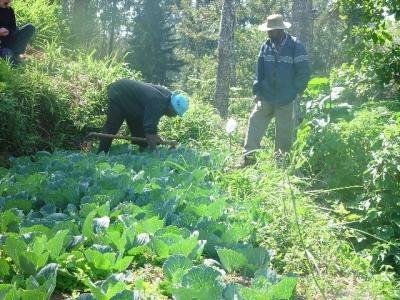
Hand weeding in a cabbage plot
A.A. Seif
Intercropping
- Intercrop brassica crops with trap crops or repellent plants, to reduce pest infestation. Tomato reportedly repels diamondback moth and Indian mustard acts as a trap crop. Intercropping brassicas with spinach, beans or dill reportedly reduces aphid infestation.
- Tomatoes when planted 14 days before cabbage reduce the incidence of and damage by diamondback moth. Cabbage intercropped with tomato, coriander or garlic, combined with the application of neem seed kernel extract protects plants from diamondback moth in the field. Indian mustard, Chinese cabbage, and radish are good trap crops for controlling cabbage webworm, flea hopper, and mustard aphid when planted in every 15 rows of cabbage. The mustard row is either in the outermost or in the middle row to avoid caterpillars being blown by wind into the cabbage plants. To control cabbage head caterpillar, Indian mustard should be planted 12 days before transplanting cabbage. Do not plant cabbage where members of the cabbage family have been grown for 3 consecutive years to avoid serious problems of pests and diseases (especially soil borne diseases).
Monitoring
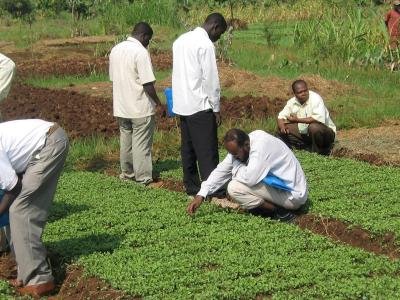
Scouting on a kale nursery by icipe trainees
A.A. Seif
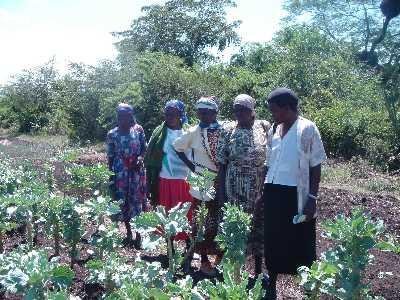
Kale . Small scale farmers inspecting a kale crop.
Monique Hunziker, Biovision
It entails regular field observation during the crop production cycle for pests, diseases, weeds and general aspects of crop health like nutrition and water requirements. Field monitoring methods are virtually the same, but most importantly, in the process is problem recognition. Thus it is very important to be able to identify pests and diseases and to differentiate a pest from a beneficial insect, a pest damage from disease damage, and a pest or disease damage from nutritional problems or physiological disorders.
- Monitor fields regularly for pest and disease occurrence. Early detection of pests and diseases is important as outbreaks are easier controlled in the initial stages. Cutworms and other insects can do a lot of damage in just 1 or 2 days.
- Scout for caterpillar presence: feeding damage and caterpillar excrement give an indication of their activity. Scouting can be done by walking in a zigzag pattern through the field.
- Check for aphids and whether parasitised aphids (mummies) and natural enemies such as ladybird beetles and lacewings are present. Since aphid populations are often clustered, all portions of the field should be checked. For more information on Natural enemies click here.
- Scout for the major brassica diseases (refer to major diseases below).
Cabbage grown in sunken beds and zai pits during the dry season in Migwani, Kitui, Kenya.
© Maundu, 2021
Harvesting and post harvest practices and markets
Harvest
Cabbage is often hand-harvested when heads are firm to the touch but before cracking begins. With hand harvesting, a given field is harvested two to four times to obtain heads of uniform size and maturity. Only one to three harvests of hybrid cultivars are required because of their greater uniformity. Use of uniform transplants and consistent growing conditions also helps reduce the number of harvests. Yields will vary with the season of production, cultivar, and production system used. With proper management, cabbage can produce 10-12 tons per acre. Generally, most fresh markets prefer heads that weigh on average 1-2,5 kg. For processing into coleslaw or sauerkraut, or for long-term storage, larger-headed cultivars are used.
Post-harvest practices.
To maintain the quality and prolong the storage life of cabbage heads, it is crucial to store the vegetable in a cool, well-ventilated, and dark environment, maintaining a temperature of approximately 20°C. During transportation, it is recommended to use ventilated boxes, net bags, or lightweight Hessian sacks. For transportation, use ventilated boxes, net bags, or lightweight Hessian sacks. To achieve longer storage, maintain a temperature of 1°C with high relative humidity (95–98%), which allows cabbage heads to be stored for 2–3 months.
Regularly monitor the cabbage heads for spoilage signs like decay, wilting, or discoloration. Remove any damaged or diseased heads promptly. Record the storage conditions and quality assessments to identify and address any issues (van der Vossen & Seif, 2004).
Value addition and markets
The market for cabbages and other brassicas is projected to be valued at approximately USD 39.40 billion in 2023 and is anticipated to reach USD 45.70 billion by 2028. This represents a compound annual growth rate (CAGR) of 3.01% during the forecast period from 2023 to 2028. In 2021, Cabbages ranked 610th among the world's most traded products, with a trade value of $3.7 billion. China and India are the leading global producers and exporters of cabbage. Other significant producers include the United States, Russia, and South Korea. In Africa, Egypt, Kenya, and South Africa are prominent cabbage-producing countries (globenewswire.com, Tjeertes, P., 2004).
In Africa cabbages are grown mainly for the local market. They are valuable as sources of vitamins and minerals, as well as a source of cash for small-scale farmers in rural and peri-urban areas. However, production is often constrained by damage caused by a range of pests (insects, diseases, nematodes and weeds). The range of pests attacking the different brassicas is similar, but the relative importance of individual pest species varies between the different crops. Cabbage is mainly sold fresh or as processed canned product. Processed products include those that are treated in vinegar, or fermented such as sauerkraut or kimchi. Fresh cut or lightly processed products include coleslaw and ready-to-eat salad mixes that contain shredded cabbage. Consumers generally prefer fresh green cabbage, when available, to stored cabbage. Much of the stored cabbage is grown for processing.
© Maundu, 2007
Field sanitation
Remove crop residues immediately after harvest and also remove volunteer plants from the field.
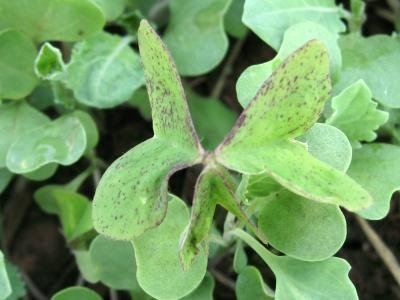
Oxalis weed in kale nursery
A.A. Seif

Nut grass(Cyperus rotundus ) in kale nursery seedbed
A.A. Seif, icipe
Varieties grown in Kenya
Cabbage varieties
"Globe Master F1 Hybrid"
"Gloria F1 Hybrid"
"Blue Dynasty F1":
"Victoria F1"
"Oxylus F1"
"Green Coronet F1 Hybrid"
"Riana F1 Hybrid"
"Super Master F1"
"Santar F1"
"Field Winner F1 Hybrid"
"CPI"
"Pruktor F1 Hybrid"
"Hero F1 (Sokoni)"
"Chihili"
"Red Dynasty F1"
"Ruby Perfection F1 Hybrid"
"Copenhagen Market"
"Glory of Enkhuizen"
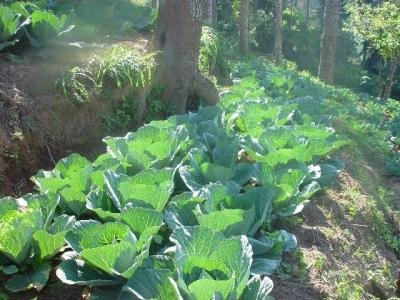
Glory of Enkuizen cabbge planted in strips
A.A. Seif
"Prize Drumhead"
"Sugar Loaf"
Broccoli varieties
"Calabrese"
"Heritage F1"
"Dandy Early No. 32 F1"
"Early Green F1"
Cauliflower varieties
"Snowball"
"Snow Crown F1 Hybrid"
"Extra Early Six Weeks"
"Kibo Giant"
"Fremont F1"
"Italian Giant"
"Wallaby"
Kale varieties
"Thousand Headed"
"Southern Georgia"
"Marrow Stem"
Fresh Quality Specifications for the Market in Kenya
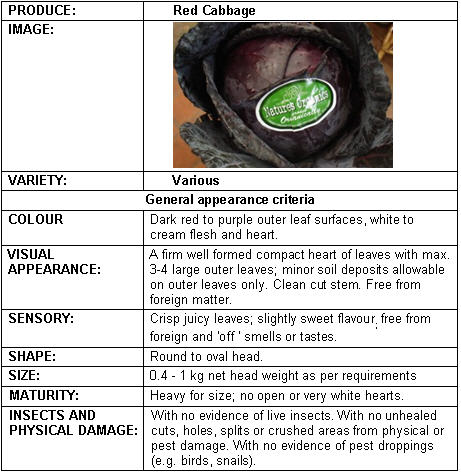 |
|
Ⓒ S. Kahumbu, Kenya |
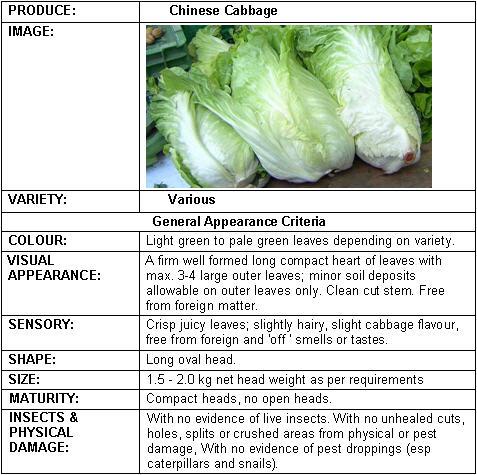 |
|
Ⓒ S. Kahumbu, Kenya
|
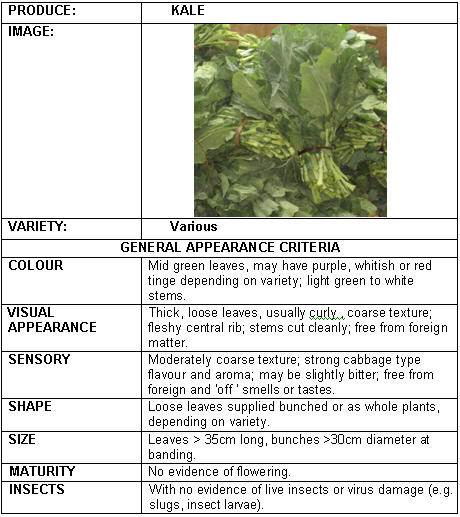 |
|
Ⓒ S. Kahumbu, Kenya |
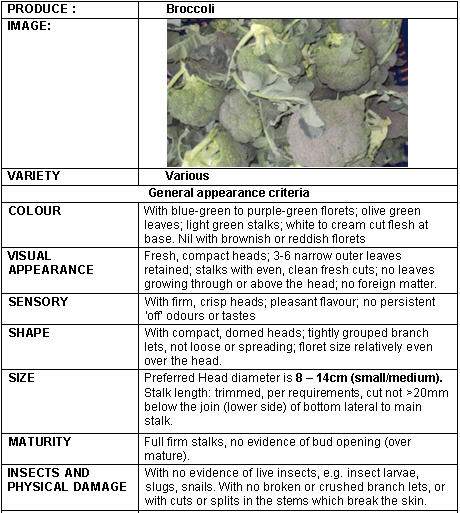 |
||||||||||||||||||||||||||||||||||||||||||||||||||||||||||||||||||||||||||||||||||||||||||||||||||||||||||||||||||||||||||||||||||||||||||||||||||||||||||||||||||||||||||||||||||||||||||||||||||||||||||||||||||||||||||||||||||||||||||||||||
|
Ⓒ S. Kahumbu, Kenya Nutritional value and recipesBrassica oleracea offers various health benefits and can they be enjoyed in many different ways, such as pickled, raw, fermented (like sauerkraut), or cooked through various methods. It is nutritious, containing vitamins, minerals, and antioxidants. With its high water content and low sodium levels, it is suitable for people with diabetes. B. Olearacea also provides dietary fiber, promoting digestion and regular bowel movements. Some brassicas like the cabbage, kale and broccoli may have good amounts of potassium, helping to regulate blood pressure and heart rate. The kale has good amounts of iron for red blood cell formation. Brassica oleracea species also have powerful antioxidants that protect against damage from free radicals, potentially preventing cancer. Their soluble fiber and plant sterols contribute to lowering LDL (bad) cholesterol and reducing the risk of heart disease. Additional health benefits include their high levels of vitamin C and vitamin K, which support heart health, decrease inflammation, promote blood clotting and bone metabolism, and help limit neuronal damage in the brain, particularly in Alzheimer's patients. Brassica oleracea is also a good source of vitamin B6, B9, B1, and B5, which are essential for energy metabolism and the proper functioning of the nervous system (see Kubala, 2017, More et al, 2020, Adelanwa & Medugu, 2015). Their water content, particularly that of cabbage is however quite high, meaning quite good amounts would need to be eaten. White cabbage is particularly poor in the above nutrients. With their relatively lower water content and more dark green leaves, kales are much more nutritious. Table 1: Proximate nutritional composition of 100 g of vegetables
Source (Nutrient data): FAO/Government of Kenya. 2018. Kenya Food Composition Tables. Nairobi, 254 pp. http://www.fao.org/3/I9120EN/i9120en.pdf $ Draining the water several times leaches away water soluble nutrients significantly. a Lewis, J. 2019. Codex nutrient reference values. Rome. FAO and WHO b NHS (refers to saturated fat) c https://www.hsph.harvard.edu/nutritionsource/water/ d British Heart Foundation e FDA f NIH g Mayo Clinic Recipes Ingredients Preparation Variation Remarks 2. Kanzira sukuma with groundnut Ingredients Preparation Variation 3. Fried Ethiopian mustard Ingredients Preparation Remark
© Maundu, 2006 4. Fresh Ethiopian kale with pounded groundnuts Ingredients Preparation 5. Budzi, mutsalafu and sukuma wiki Method Remark
©Maundu, 2006 |
Information on Pests
The major pest constraints of brassicas in Africa were identified as the diamondback moth (DBM), cabbage aphids, cabbage webworm and Bagrada bugs.
| Several species of aphids attack brassicas in East Africa: The cabbage aphid (Brevicoryne brassicae) The false cabbage aphid (Lipaphis erysimi) The green peach aphid (Myzus persicae) In particular the cabbage aphid is a major pest in the region. Cool, dry weather is most favourable for aphid development. Large numbers of aphids may kill small plants. Their feeding can distort leaves of older plants and causes leaf curl. Often, the most serious problem associated with aphids is virus transmission. The cabbage aphid and the false cabbage aphid are vectors of virus diseases such as cabbage black ring spot, cabbage ring necrosis, and mosaic diseases of cauliflower, radish and turnip. What to do:
|
| Sawflies are sporadic but serious pests of brassicas. The cabbage sawfly (Athalia sjostedti) has been reported as a major pest in Tanzania. Sawfly adults are wasps with dark head and thorax, bright yellow abdomen, and two pairs of membranous wings. They are about 1 cm long. Eggs are laid singly inside the leaf. Larvae are oily, black or greenish in colour with a swollen part just behind the head, which makes them appear humped. They look very similar to caterpillars, but they have 6 to 9 pairs of prolegs (abdominal legs), whilst caterpillars have 5 pairs or less. Larvae measure up to 2 cm when fully grown. Larvae eat the blades of leaves leaving just the main veins. They drop from the plant to pupate in the soil.
What to do:
|
| Diamondback moth (DBM) (Plutella xylostella) It is a serious pest of brassicas and attacks all Brassica species. A full grown diamondback caterpillar is about 1 cm long.
What to do:
|
| Cabbage looper (Trichoplusia ni) The cabbage looper is a green caterpillar with faint white stripes along the body. Caterpillars are about 3.5 to 4 cm long when fully-grown. As they move, they arch their back in a looping fashion, hence the common name looper. Larvae (caterpillars) chew holes in the leaves, and larger caterpillars consume great amounts of plant material. On cabbage they eat into the heads, reducing the marketability of the produce.
The adult is a moth about 2.5 cm in length and mottled, greyish-brown. What to do:
|
| Cabbage webworm (Hellula undalis) Caterpillars are 1.5 cm when fully-grown, creamy-white in colour with brown stripes along the body and a brown head. Caterpillars feed on leaves, petioles, growing points, and stems.
What to do:
|
| Cabbage moth (Crocidolomia pavonana (=binotalis)) Cabbage moth larva: when fully grown is about 1.6-1.9 cm long. Larvae pupate in the soil. The pupal stage lasts about 10 days. It is primarily a pest of brassicas and is occasionally an important pest of cabbage and kales. Caterpillars are found in groups. Young caterpillars chew off top leaf surfaces, while older caterpillars feed under a web of silk on young leaves, petioles and growing point of the plant, often damaging it entirely. What to do:
|
| It is typically shield-shaped, 5-7mm long and 3-4mm wide. The upper surface has a mixture of black, white and orange markings. Feeding by sucking by both adults and nymphs causes damage to leaves, which wilt later and dry. A heavy attack on young plants generally results in death of the plant. What to do:
|
| Cutworms cut the stem of plants below the soil surface. The damaged plant wilts and withers. First instars are 0.7-1 cm, later instars are 3.5-5 cm long. What to do:
|
| Leafmining flies (Lyriomiza brassicae) Leafmining flies are small about 1.3-1.6 mm in length. Maggots of leafmining flies cause mines while feeding within the leaf. Small, individual leafminers do not produce much damage, but when larvae occur in large numbers, entire leaves can be eaten out. Heavy attacks weaken seedlings and may result in dying off the young plants. What to do:
|
| Thrips (Thrips tabaci Frankliniella spp) Thrips feeding on cabbage cause rough bronzed blisters on leaves inside the cabbage head. hey are less than 2 mm long. Thrips attacks are not common on brassicas in the eastern and southern Africa region. What to do:
|
| Whiteflies (Bemisia tabaci, Trialeurodes vaporariorum and Aleyrodes proletella) Whiteflies feed on brassicas. Adult whiteflies are about 1 mm long. In East Africa whitefly populations on brassicas usually do not build up to such an extent that control measures are required. What to do:
|
Information on Diseases
The most important diseases are blackrot, blackleg, black spot and Turnip Mosaic Virus
| Black rot (Xanthomonas campestris pv. campestris) Black rot is caused by the bacterium Xanthomonas campestris pv. campestris, and is one of the most serious cabbage diseases in warm climates. The black rot bacterium can over-season on infected cabbage seeds, in weeds from the family Cruciferae (including: black mustard, field mustard, wild turnip, wild radish, shepherd's purse, and pepperweed); or in infected plant material in the soil. What to do:
|
| It affects every known cruciferous crop. However, this disease is generally less common on cabbage, Brussels sprouts, broccoli and cauliflower than on radish, horseradish, mustard and turnip. Leaves have chlorotic or necrotic spots on their upper surface. Pustules form on the lower side of the leaves, small stems and floral parts. What to do:
|
| Alternaria leaf spot (Alternaria brassicae) Alternaria leaf spot or black spot is caused by the fungus Alternaria brassicae. The disease can severely damage cabbage if uncontrolled. The initial symptoms are small, circular, dark spots on older leaf surfaces. As the spots enlarge, concentric rings develop within lesions surrounded by a yellow halo. The tan-coloured centres of lesions may eventually fall out, producing a hole, or under wet conditions, may become covered with masses of black spores. In storage, spots enlarge and soft-rot bacteria may enter lesions. The pathogen can over-season on crop debris. Weeds from the family Cruciferae may also harbour the fungus. Spores of Alternaria can be spread by wind and water. The disease is most damaging under wet, warm (20-30.5 degC) conditions. What to do:
|
| Clubroot (Plasmodiophora brassicae) Clubroot caused by the slime mould fungus Plasmodiophora brassicae is particularly serious in Malawi. Its distinctive symptom is an abnormal enlargement of roots or even the underground stem. Its development is favoured by wet, cool, acidic soils. What to do:
|
| It is serious cabbage disease caused by the fungus Leptosphaeria maculans (Phoma lingam). Symptoms of black leg usually appear as oval, sunken, light brown cankers, often with a black or purple margin, near the base of the stem. The canker enlarges until the stem is girdled and the plant wilts and dies. Severely infected plants are stunted. Infected plants eventually wilt and then turn dull blue-red. With black leg, plants may suddenly collapse due to stem deterioration.
Host range: It includes most of crucifers, but with varying degrees of susceptibility. Most susceptible: cabbages, Swedes, kohlrabi and white mustard. Medium susceptible: cauliflower, turnip, broccoli, rape, kale and collards. Resistant: horseradish, winter-cress, shepherd's purse and pepper grass.
Symptoms: All above parts of a plant may be affected from seedbed to harvest.
Seedlings: Cotyledon infection causes seedlings to die early. This is often overlooked in the seedbed. Stems: An elongated, light brown, sunken spot or lesion with purplish margin forms on stems near the soil line. Lesions gradually extend upward and downward and eventually girdle the stem and the stem turns black. Small, black dots (fruiting bodies of the fungus: pycnidia) appear on the affected area. Internally, the affected stem shows a brown, dry rot. Affected plants often wilt suddenly and die or topple over later as the heads in case of cabbages enlarge.
Leaves: Inconspicuous, circular, light brown to grayish spots form on leaves. The spots soon become well defined and develop ash-gray centres in which large number of minute black bodies (pycnidia) are scattered. The presence of pycnidia on cotyledons, leaves and stems distiguishes blackleg from other crucifer diseases. What to do:
|
| Bacterial soft rot (Erwinia carotovora var. carotovora) Bacterial soft rot is caused by Erwinia carotovora var. carotovora. It is quite common on Chinese cabbage in the field. On cabbage, turnip and rutabaga the disease may be found in the field, but is most severe during storage. On cabbage, an initial infection occurs on the outer petiole (leafstalk) which is in contact with the soil, and then progresses to its head. An infected head is watery and often has a complete head rot. The affected area becomes soft and mushy and generally turns dark in colour. Soft rot infection on crucifers almost always emits a foul odour. Eventually the leaves, sterns and roots are entirely decayed by the bacteria. The bacterium is spread in the field by water splashes or contact with tools such as hoes or knives. If contaminated knives are used to harvest cabbages, the stored crop may also rot quickly. What to do:
|
| Cercospora leafspots (Cercospora brassicicola) Cercospora leaf spots is caused by the fungus Cercospora brassicicola. Leafspots vary in colour from pale green to white and generally are bordered by brown tissue. They may be circular or appear angular. Severely affected plants may become defoliated. This disease is not economically important in the East African region. What to do:
|
| Cauliflower Mosaic Virus (CaMV) It shows systemic symptoms such as a clearing along the leaf veins (vein clearing). This often is seen first at the base of a leaf. Later symptoms appear as dark green areas along veins (vein banding) and necrotic spotting of the leaf. Chinese cabbage is particularly susceptible to CaMV. In addition to vein clearing a striking mosaic may develop with light and dark green areas seen on the leaves. Plants can be stunted. The main source of CaMV are plants of an infected brassica crop or cruciferous weeds on which a vector has over-seasoned. The virus is transmitted by many species of aphids, such as the cabbage aphid. What to do:
|
| Damping-off diseases (Pythium spp., Rhizoctonia solani, Fusarium spp.) In crucifers, several fungi (e.g. Pythium spp., Rhizoctonia solani, Fusarium spp.) can cause damping-off diseases.
Characteristic is wirestem of seedlings caused by Rhizoctonia solani in the seedbed, bottom rot and head rot in the field, and storage and root rot of horseradish, radish, rutabaga and turnip.
Damping-off diseases are favoured by cool, wet soil conditions. What to do:
|
| The first symptoms to develop when Brassica seedlings are inoculated with TuMV are chlorotic spots on inoculated leaves, mottling followed by systemic vein clearing, mosaic and/or necrosis, leaf distortion and often stunting. What to do:
|
| Ring spots (Mycosphaerella brassicicola) Ring spots are small, purple spots surrounded by a ring of water-soaked tissue on leaves which mature to brown spots with olive green borders 1-2 cm wide. The spots may develop numerous fruiting bodies which give them a black appearance or develop a concentric pattern. Heavily infected leaves may dry up and curl inwards. Ring spot requires cool, moist conditions to develop. What to do:
|
| Powdery mildew (Erysiphe polygoni) Powdery mildew is a fungal disease which appears as white, powdery spots that may form on both surfaces of leaves, on shoots, and sometimes on flowers and fruit. These spots gradually spread over a large area of the leaves and stems. Leaves infected with powdery mildew may gradually turn completely yellow, die, and fall off, which exposes cabbage head to sunburn. What to do:
|
| Downy mildew on cabbage (Peronospora parasitica) Downy mildew is caused by a fungus which mainly attacks foliage. It is responsible for substantial losses in seedling production, especially during the cooler months. Young cabbage plants are more susceptible than older plants. The powdery white spores are the major means of dispersal of the fungus, especially once it is established within seedlings crops. Spores are produced overnight and released the following morning as the air dries out. They are dispersed by wind and rain splash. Downy mildew disease development is favored by cool, moist conditions. Downy mildew disease is first seen as a fluffy or powdery-white mass of spores on the undersurface of brassica seed leaves (cotyledons). This is followed by a black speckling and puckering of the upper surface. Leaves prematurely yellow and fall from the plants. Symptoms on mature plants in the field are generally confined to the leaves closest to the ground. The fungus produces spores on the under surface, and brown to black, sunken, angular, pepper-like lesions on the upper surface of leaves. The fungus can cause black lesions on cabbage heads and breakdown of cauliflower curds in storage. What to do:
|
| Cottony rot (Sclerotinia sclerotiorum) Sclerotinia sclerotiorum is a fungus which can survive on infected tissues, in the soil, and on living plants. It causes white mold on cabbage, soybeans, green beans, sunflowers, canola, and peanuts. S. sclerotiorum affects young seedlings, mature plants, and fruit in the field or in storage. Cottony rot begins as tan, water-soaked, circular areas, which become covered by white, cottony fungal growth. As the disease progresses, the host tissue becomes soft and watery. The fungus eventually colonizes the entire cabbage head and produces large, black, seed like structures called sclerotia on the diseased tissue. Plants with root infection often wilt and die prematurely. What to do:
|
Contact Information
- Amiran Kenya Ltd: pr@amirankenya.com, +254 (0) 719 095 000
- Corner Shop, Nairobi: cornershop@africaonline.co.ke, +254 (0) 0716 905 486, (20) 2712268/9
- East African Seed Company Ltd: www.easeed.com, + 254 (20) 6652101-4, +254 (0) 722 207 747
- Green Dreams: info@organic.co.ke +254 (0) 724 781 971/ 0722 562 717
- Horticultural Crops Directorate: info@agricultureauthority.go.ke, +254 20 2536869, 0722 200 556
- Kalimoni Greens: www.kalimonigreens.com , +254 (0) 708 278 273
- Karen Provision Stores, Nairobi: kps@nbi.ispkenya.com +254 20 882 252, 0736 371 437
- Muthaiga Green Grocers, Nairobi
- Nakumatt Supermarket: info@nakumatt.net, +254 (0) 733 632 130, 0722 204 931, (20) 3599991-4
- Horticulture Research Institute, Thika: director.hri@kalro.org. +254 (20) 2055038
- Simlaw Seeds Co. Ltd: info@simlaw.co.ke, +254 (0) 0722 200 545 / 0734 811 861, (20) 2215067
- Uchumi Supermarket: info@uchumi.com +254 20 8020081 - 5, 0733 410 028,
- Zuchinni Green Grocers, Nairobi: +254 (20) 2215067
References and information Source Links
References
- African museums.https://www.africamuseum.be/en/research/collections_libraries/biology/prelude/view_plant?pi=02047
- AVRDC Training Center: Cabbage www.avrdc.org
- CAB International (2005). Crop Protection Compendium, 2005 edition. Wallingford, UK www.cabi.org
- CAB International (2021). Crop Protection Compendium, 2005 edition. Wallingford, UK www.cabi.org
- Dobson, H., Cooper, J., Manyangarirwa, W., Karuma, J., Chiimba, W. (2002). Integrated Vegetable Pest Management. Natural Resources Institute, University of Greenwich, UK. ISBN: 0-85954-536-9
- East African Seed Co. Ltd. Africa's Best Grower^s Guide www.easeed.com
- Nega, E., Ulrich, R. Werner, S. und Jahn, M. (2003). Hot water treatment of vegetable seed - an alternative seed treatment method to control seed borne pathogens in organic farming. Journal of Plant Diseases and Protection 110(3):. 220-234. www.orgprints.org
- Nutrition Data www.nutritiondata.com.
- OISAT: Organisation for Non-Chemical Pest Management in the Tropics www.oisat.org
- Varela, A.M., Seif, A. A., Lohr, B. (2003). A Guide to IPM in Brassicas Production in Eastern and Southern Africa. ICIPE Science Press, Nairobi. ISBN: 92 9064 148 7
- Poveda, J., Zabalgogeazcoa, I., Soengas, P., Rodríguez, V. M., Cartea, M. E., Abilleira, R., & Velasco, P. (2020). Brassica oleracea var. acephala (kale) improvement by biological activity of root endophytic fungi. Scientific Reports, 10(1), 20224.
- Okamoto, T., Wei, X., Mehraj, H., Hossain, M. R., Akter, A., Miyaji, N., .. & Watanabe, M. (2021). Chinese Cabbage (Brassica rapa L. var. pekinensis) Breeding: Application of Molecular Technology. Advances in Plant Breeding Strategies: Vegetable Crops: Volume 10: Leaves, Flowerheads, Green Pods, Mushrooms and Truffles, 59-94.
- Tjeertes, P., 2004. Brassica oleracea L. (cauliflower and broccoli) [Internet] Record from PROTA4U. Grubben, G.J.H. & Denton, O.A. (Editors). PROTA (Plant Resources of Tropical Africa / Ressources végétales de l’Afrique tropicale), Wageningen, Netherlands. Accessed 30 June 2023.
- PlantVillage. (n.d.). Broccoli. Retrieved Month Day, Year, from https://plantvillage.psu.edu/topics/broccoli/infos
- Kubala, J. (2017). 9 Impressive Health Benefits of Cabbage. Healthline. Healthline Media, November, 4.https://www.healthline.com/nutrition/benefits-of-cabbage
- https://www.healthline.com/nutrition/purple-cabbage
- Moreb, N., Murphy, A., Jaiswal, S., & Jaiswal, A. K. (2020). Cabbage. Nutritional Composition and Antioxidant Properties of Fruits and Vegetables, 33-54.https://www.sciencedirect.com/science/article/abs/pii/B9780128127803000039
- https://www.webmd.com/food-recipes/ss/slideshow-cabbage-benefits
- Adelanwa, E. B., & Medugu, J. M. (2015). Variation in the nutrient composition of red and. Journal of Applied Agricultural Research, 7, 183-189.https://www.researchgate.net/profile/Esther-Adelanwa-2/publication/320058505_VARIATION_IN_THE_NUTRIENT_COMPOSITION_OF_RED_AND_GREEN_CABBAGE_Brassica_oleracea_WITH_RESPECT_TO_AGE_AT_HARVEST/links/59cb89bc0f7e9bbfdc3b384e/VARIATION-IN-THE-NUTRIENT-COMPOSITION-OF-RED-AND-GREEN-CABBAGE-Brassica-oleracea-WITH-RESPECT-TO-AGE-AT-HARVEST.pdf
Information source links
- https://www.specialtyproduce.com/produce/Red_Russian_Kale_5959.php
- https://plants.ces.ncsu.edu/plants/brassica-oleracea-acephala-group/
- https://specialtyproduce.com/produce/Broccoli_784.php
- https://www.globenewswire.com/news-release/2020/02/19/1987215/0/en/Worldwide-Market-Insights-for-Cabbage-and-Other-Brassicas-2007-2025.html
- https://www.nutrition-and-you.com/cabbage.html
- AVRDC Training Center: Cabbage www.avrdc.org
- CAB International (2005). Crop Protection Compendium, 2005 edition. Wallingford, UK www.cabi.org
- Dobson, H., Cooper, J., Manyangarirwa, W., Karuma, J., Chiimba, W. (2002). Integrated Vegetable Pest Management. Natural Resources Institute, University of Greenwich, UK. ISBN: 0-85954-536-9
- East African Seed Co. Ltd. Africa's Best Grower^s Guide www.easeed.com
- Nega, E., Ulrich, R. Werner, S. und Jahn, M. (2003). Hot water treatment of vegetable seed - an alternative seed treatment method to control seed borne pathogens in organic farming. Journal of Plant Diseases and Protection 110(3):. 220-234. www.orgprints.org
- Nutrition Data www.nutritiondata.com.
- OISAT: Organisation for Non-Chemical Pest Management in the Tropics www.oisat.org
- Varela, A.M., Seif, A. A., Löhr, B. (2003). A Guide to IPM in Brassicas Production in Eastern and Southern Africa. ICIPE Science Press, Nairobi. ISBN: 92 9064 148 7
Review Process
Patrick Maundu, James Kioko, Charei Munene, Monique Hunziker, March 2024.

